Some tourist attractions are so iconic that they’ve become synonymous with the country they’re in.
Mention France and one of the first things that comes to mind is the Eiffel Tower. Tell people you’ve been to Peru and they’ll assume you were there for Machu Picchu. The Great Wall will forever be a symbol of China while the Statue of Liberty remains a powerful symbol of the United States of America.
In Egypt, that one iconic attraction will always be the Great Pyramid of Giza.
Thanks to the pyramids, Egypt is a bucket list destination for many travelers but the one draw that’s often overlooked is traditional Egyptian food.
Egypt has a long culinary history that dates back to ancient times. It boasts a rich cuisine that gives Traveleaters much to look forward to in Cairo, especially those with a taste for vegetarian food.
The pyramids may be the country’s biggest draw but delicious traditional Egyptian dishes like ful medames, koshari, falafel, and shawarma will keep you coming back for more.
Save This on Pinterest!
No time to read this Egyptian food guide now? Click on the save button and pin it for later!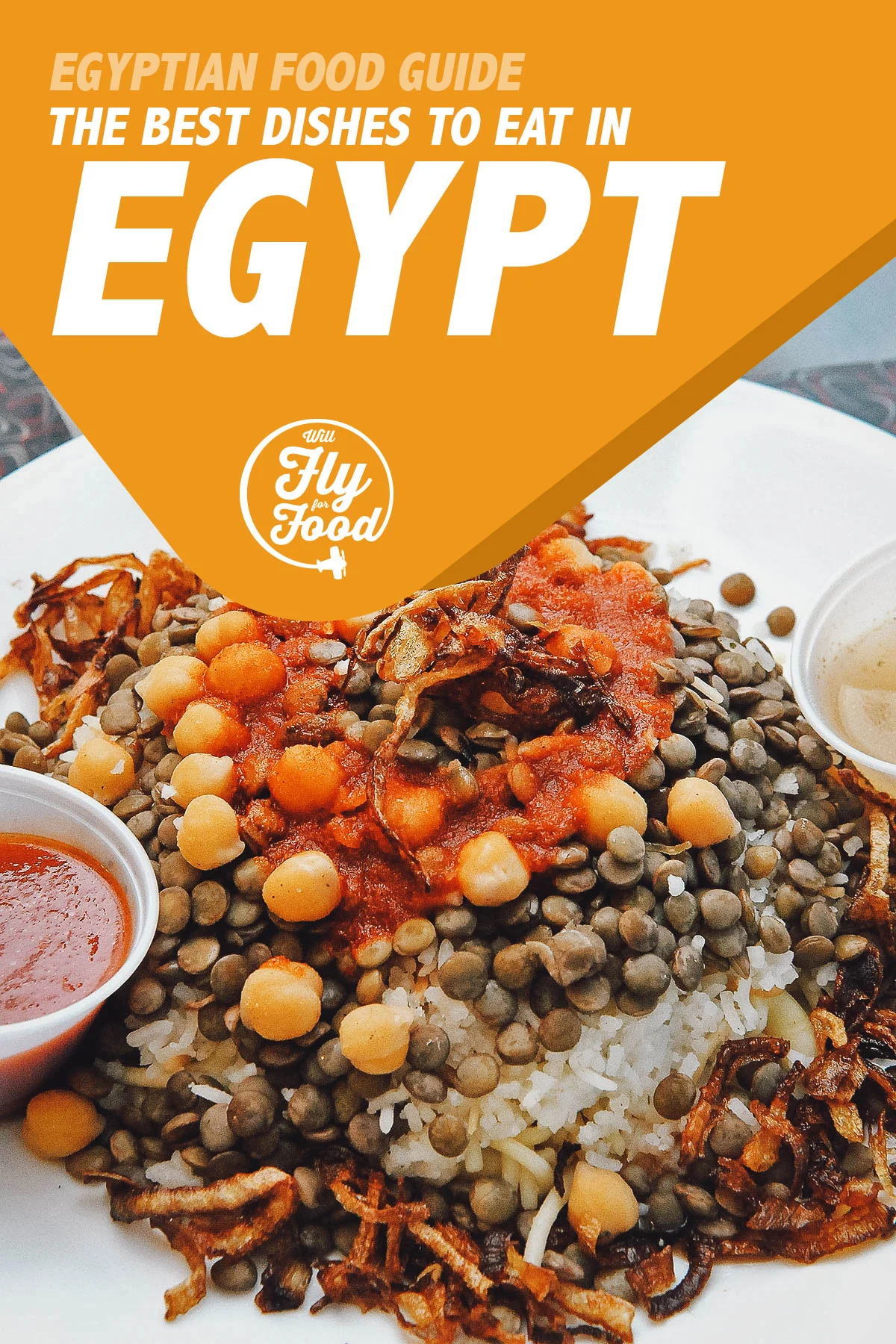
Photo by TDCPhoto
WHAT IS TRADITIONAL EGYPTIAN FOOD?
Legumes, vegetables, and fruit grown in Egypt’s rich Nile Valley and Delta feature prominently in Egyptian cuisine. While fish and seafood are common in Egypt’s coastal regions, a significant amount of traditional Egyptian food is vegetarian. This is due to the historically high price of meat in Egypt and the dietary needs of the Coptic Christian community.
Commonly used meats in Egyptian cuisine include squab, chicken, duck, and lamb. Lamb and beef are often used for grilling while dishes made with offal are a popular fast food in many Egyptian cities.
People with a taste for cumin will be happy to know that it’s the most frequently used spice in Egyptian cooking. Other common spices and herbs used in Egyptian recipes include cinnamon, cardamom, coriander, cloves, chili peppers, parsley, bay leaves, and dill.
Tea, especially mint tea, is very popular in Cairo and Egypt while beer is the most consumed alcoholic beverage.
THE BEST TRADITIONAL EGYPTIAN FOOD
This Egyptian food guide has been organized by category to make it easier to go through. Click on a link to jump to any section of the guide.
BREAD
1. Aish Baladi
Bread is a vital component in many cuisines. Its role is often two-fold – not only is it an important part of the meal itself, but it often serves as a utensil or vessel in the consumption of food. Such is the case with Egyptian food and aish baladi.
Aish baladi (or eish baladi) is the Egyptian version of pita bread. It’s made with 100% whole wheat flour baked at extremely hot temperatures. It’s baked several times a day in Cairo and eaten at every meal so you never have to settle for stale bread in Egypt.
This type of flatbread has been produced since ancient Egyptian times. Back then, it was made with an ancient grain known as emmer wheat. Wild yeast would help the dough rise which would then be baked in traditional Egyptian clay ovens made with red mud from the Nile River.
Since ancient times, aish baladi has been a cornerstone of Egyptian cuisine. In fact, you can tell just how important it is to Egyptian culture by its name. Baladi means “traditional” or “authentic” while aish means “life”. Consumed everyday across all social classes in Egypt, it’s something that Egyptians simply cannot live without.
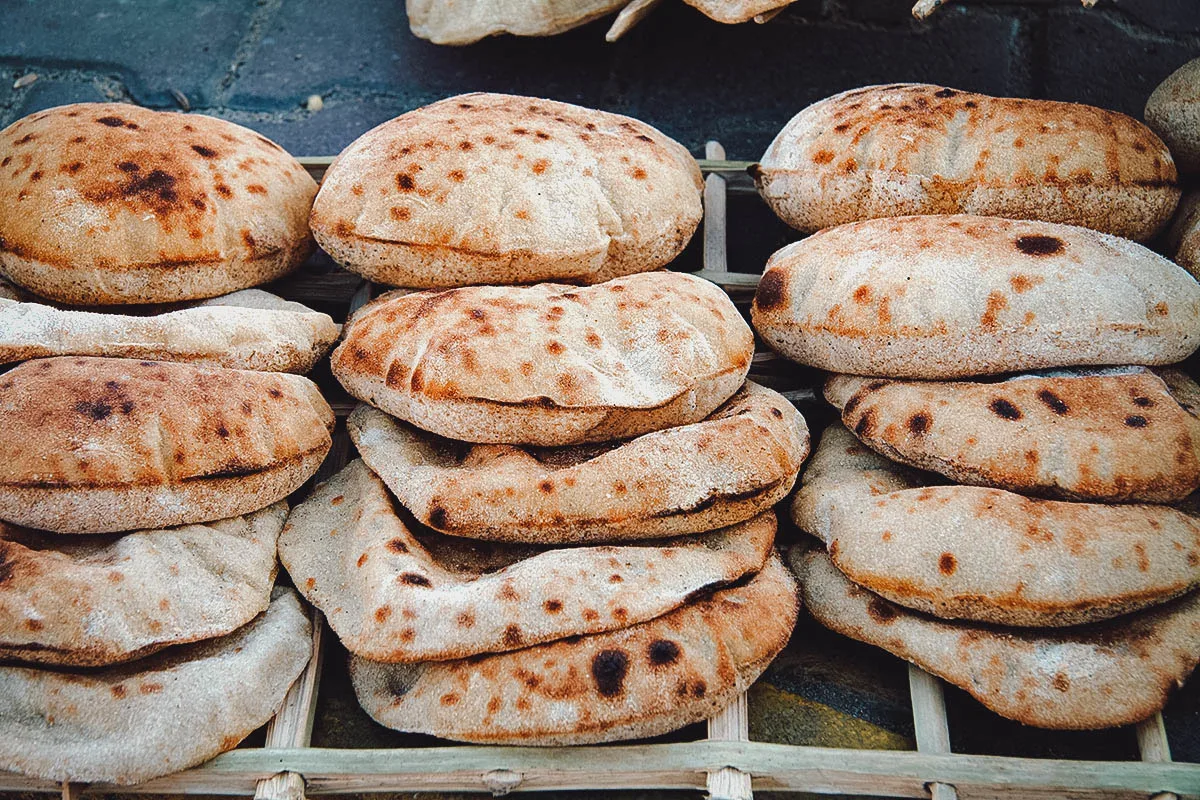
Photo by mayeruwe
VEGETARIAN
2. Hummus
If you’re looking for something delicious to pair with your aish baladi, then look no further than hummus. An Egyptian food favorite that’s popular throughout the Middle East, it refers to a type of savory dip made from cooked mashed chickpeas blended with tahini, garlic, cumin, and lemon juice.
The word hummus means “chickpeas” in Arabic and is a shortened version of the dish’s full name ḥummuṣ bi ṭaḥīna, meaning “chickpeas with tahini”. The exact origins of the dish are unclear, but the earliest written recipes for a dish resembling hummus are recorded in cookbooks written in 13th century Cairo.
Typically eaten as an appetizer or dip, or as an accompaniment to other Egyptian dishes like falafel, hummus is usually served with pita bread and garnishes like olive oil, whole chickpeas, paprika, and herbs.
Interestingly, records indicate that Egyptians from the 13th and 14th centuries enjoyed a version of the dish called hummus kasa, which means “crushed hummus”. It appears to be a chunkier, less blended version of hummus made with the addition of coarsely chopped nuts. You can click on the link for the recipe.
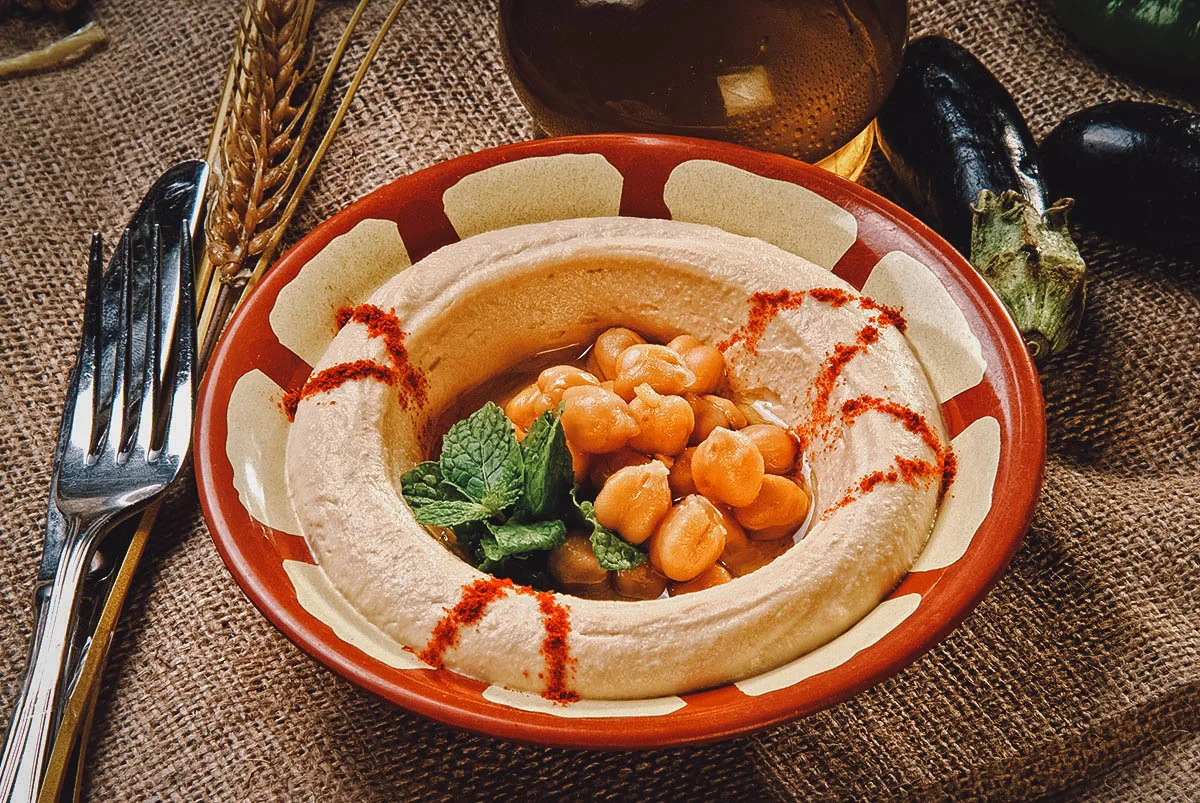
Photo by Manowar1973
3. Baba Ghanoush
Like hummus, baba ghanoush (or baba ghanouj) is one of the most popular dips served in Egyptian cuisine. Originally from Lebanon, it consists of mashed cooked eggplant blended with tahini, garlic, olive oil, lemon juice, herbs, and spices.
What I love most about baba ghanoush is its deliciously smokey flavor derived from roasted eggplant. It’s made by broiling or roasting the eggplant over an open flame and then peeling and blending it with the rest of the ingredients.
Baba ghanoush is typically served cold in Egypt, often as part of a mezze platter with pita bread or as a side dish with larger meals.
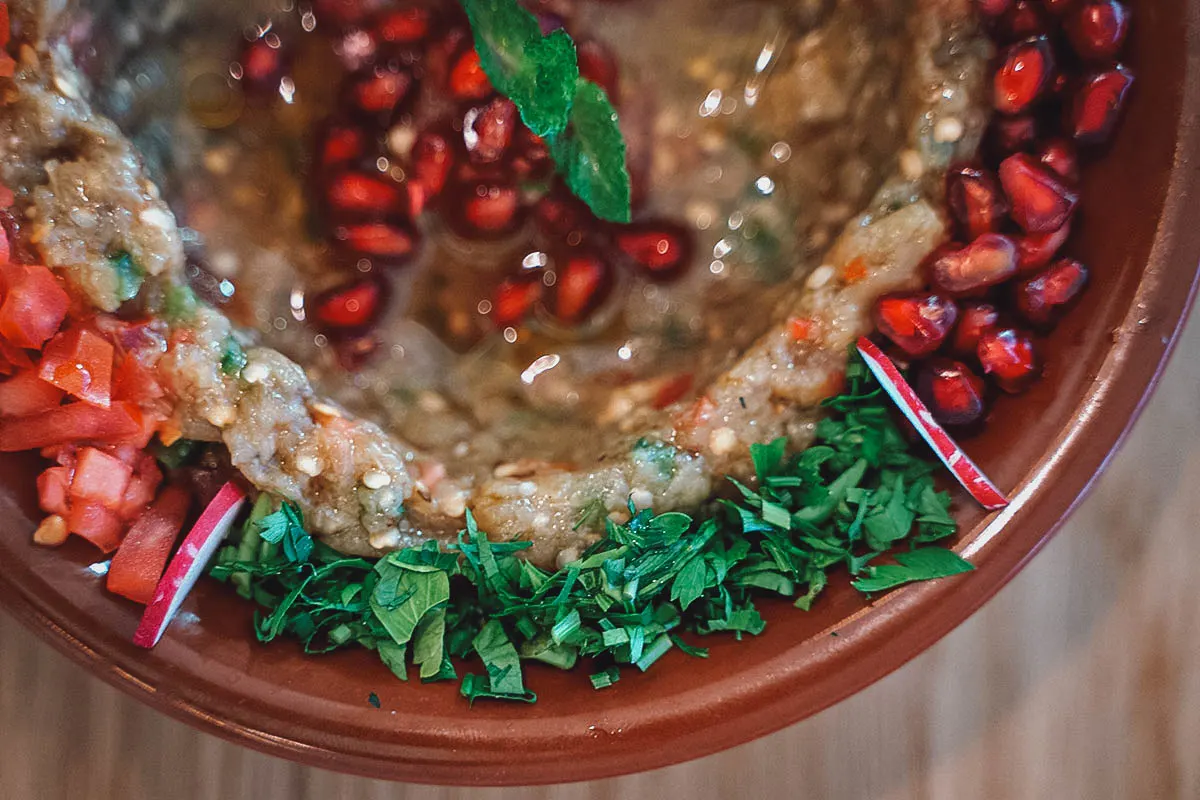
Photo by [email protected]
4. Ful Medames
Egyptian food gives vegetarians plenty to look forward to and ful medames may be one of the most delicious ones yet. An Egyptian national dish, it refers to a stew of creamy fava beans cooked with cumin, olive oil, garlic, lemon juice, herbs, and spices.
Ful medames (or foul mudammas) is an Egyptian food staple but it’s also popular in other countries throughout the Middle East, the Levant, and North Africa. Like aish baladi, it’s an everyday Egyptian dish that can be consumed at any time of the day – for late breakfast, lunch, or even dinner. Like hummus and baba ghanoush, ful medames is typically eaten as a dip with warm pita bread.
Ful medames is typically made with fūl ḥammām or “bath beans” but it can be made with other types of fava beans as well like fūl rūmī (European broad beans) and fūl baladī (country beans).
It’s interesting to learn that in the Middle Ages, the cooking of fava beans for ful medames was monopolized by people living around the Princess Baths in Cairo, a public bath near the Mosque of Sultan al-Muayyad. During the day, bath attendants would stoke fires to heat huge pots of bath water called qidras. After the bath closed at night, the fires would continue to burn so they’d simmer fava beans in the qidras and sell them the next morning.
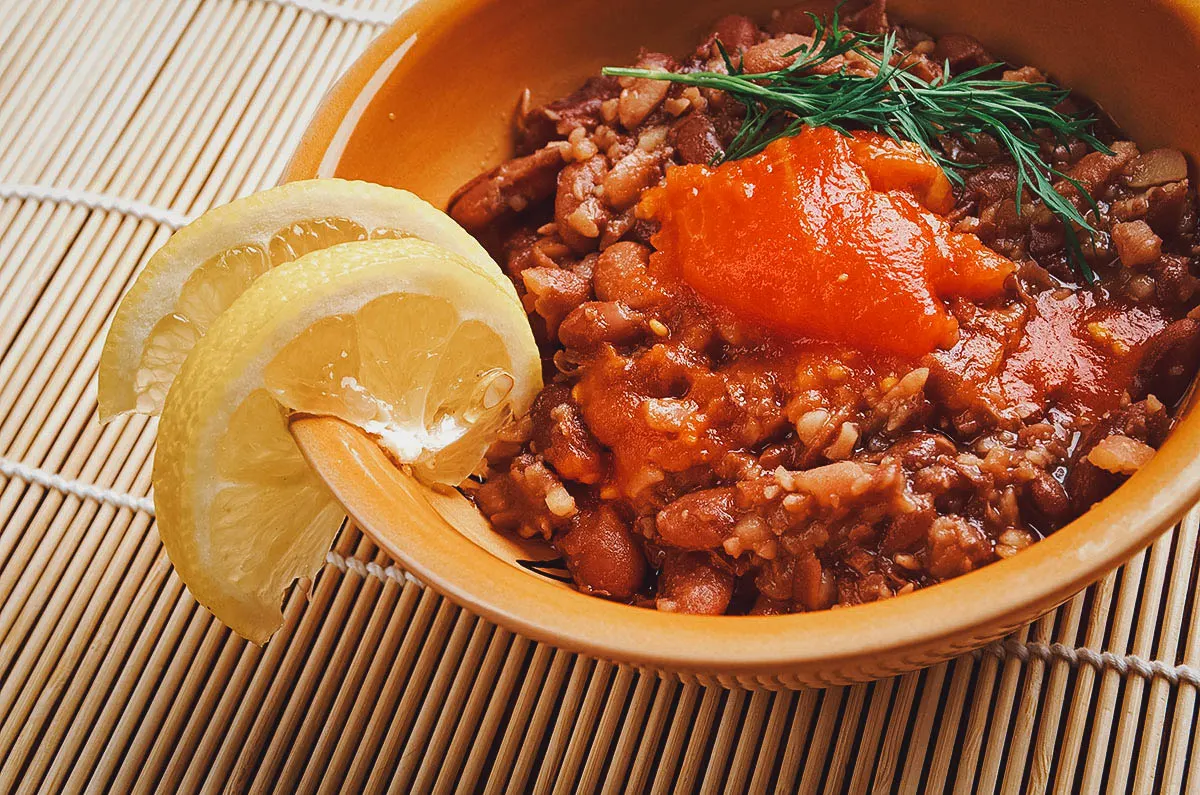
Photo by fanfon
5. Koshari
Koshari (or kushari, koshary) is another Egyptian national dish. A popular street food in Cairo and the rest of Egypt, it consists of lentils, white rice, chickpeas, and macaroni topped with a spiced tomato sauce and crispy fried onions.
Koshari dates back to mid-19th century Egypt and is essentially a dish that was thrown together to make use of leftover pantry staples. Leftover white rice, lentils, and macaroni were mixed together and topped with whole chickpeas, fried onions, and a garlic-vinegar-spiked tomato sauce.
Initially, kosahri was sold from street carts in Egypt and was popular mainly among workers and laborers. It would later be introduced to restaurants and has now become one of the most beloved comfort foods in Egypt.
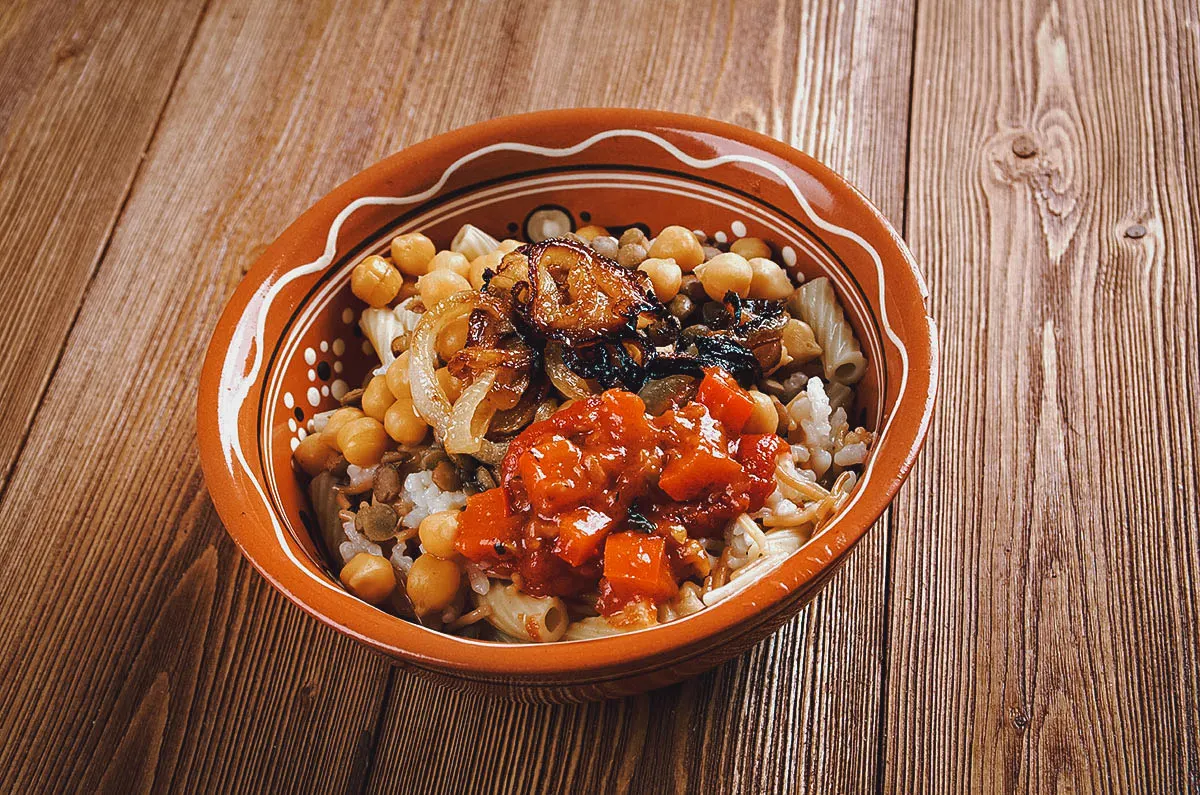
Photo by fanfon
6. Molokhia
Molokhia (or mulukhiyah, molokheyya) refers to both the Egyptian soup and the leafy vegetable used to make it. Like ful medames and koshari, it’s classic comfort food in Egypt and considered by many to be an Egyptian national dish.
Molokhia is made with the leaves of the Corchorus plant, a leafy shrub commonly known as jute mallow, Jew’s mallow, or nalta jute. Aside from Egypt, it’s used in the cuisines of many other countries like Tunisia, Kenya, Haiti, and the Philippines.
Egyptian molokhia is made with finely chopped jute leaves boiled in chicken broth with sauteed garlic, coriander, and seasonings. When cooked, molokhia takes on a somewhat slimy viscosity similar to okra. The soup is typically served with rice or Egyptian flatbread and is often paired with meat dishes like roasted chicken, rabbit, or seafood.
Molokhia is a dish that many Egyptians grew up eating. According to this Egyptian food blogger, it’s used by many mothers to introduce new vegetables into their children’s diet. Most Egyptian kids take to molokhia from an early age so mothers would hide finely chopped vegetables like carrots, broccoli, peas, and beans in their mound of molokhia and rice. Sneaky!
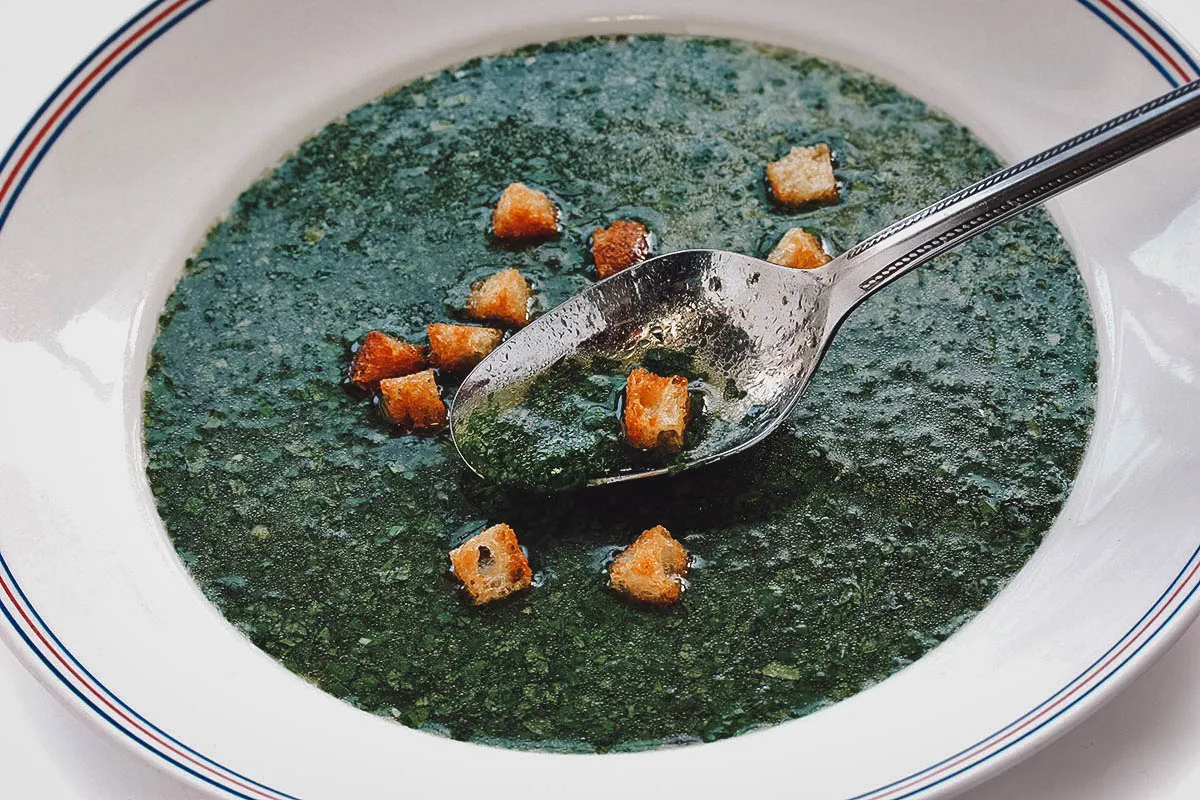
Photo by asimojet
7. Shakshuka
Shakshuka (or shakshouka) is one of the most internationally well-known dishes in North African cuisine. It’s widely consumed in the Levant and Israel but its roots are in North Africa, most likely Tunisia.
Originally a Maghrebi dish, shakshuka is made with eggs poached in a tomato sauce made with tomatoes, garlic, green pepper, bell peppers, onions, and olive oil. It’s a delicious and simple one-skillet dish flavored with herbs and spices like parsley, mint, coriander, paprika, and cumin. The word shakshuka in Arabic means “shaken together” or “mixed”.
Shakshuka is typically eaten for breakfast or brunch, especially in Israel, but it can be enjoyed at any time of the day. It’s best paired with flatbread and salad and is often served as part of a larger mezze platter with hummus, falafel, and other traditional Egyptian dishes.
Shakshuka is traditionally a vegetarian dish but it can be made with meat like ground beef or ground lamb as well. You can even find a green variation of the classic recipe that substitutes tomatoes with leafy vegetables like spinach, kale, collard greens, and brussel sprouts.
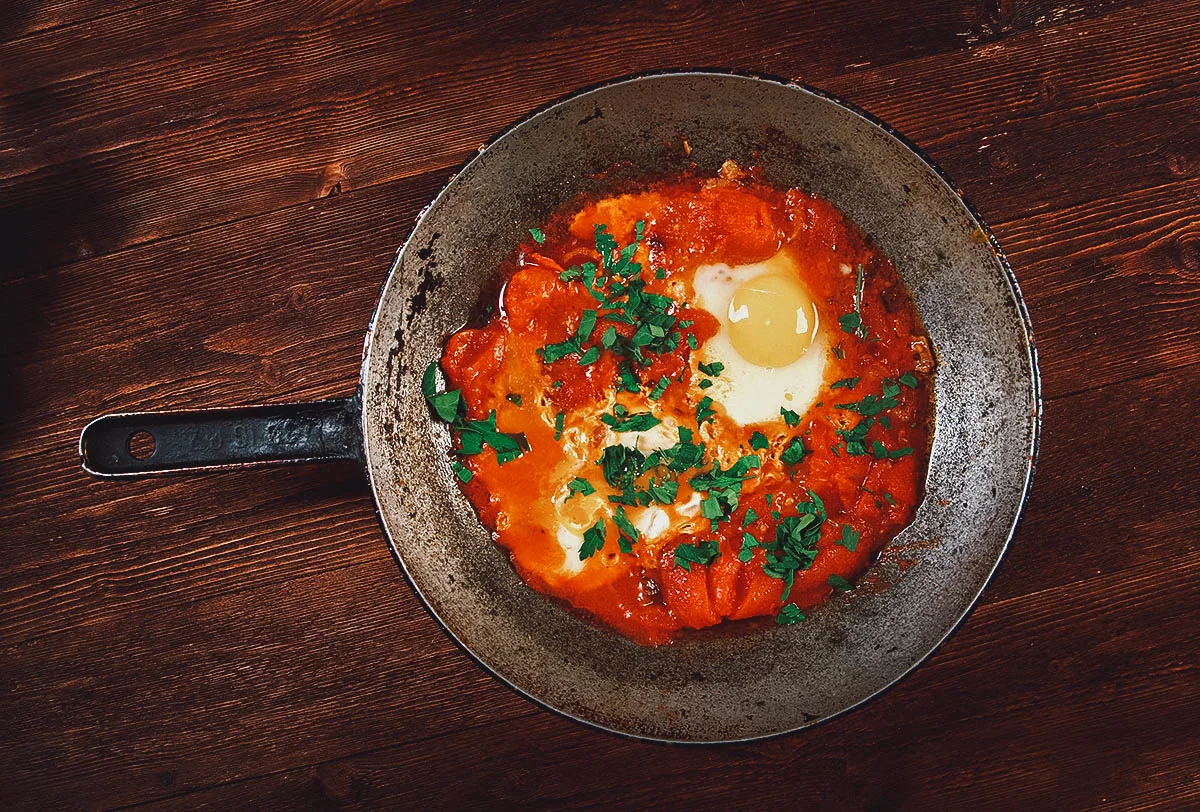
Photo by fanfon
8. Eggah
Eggah (or ej’jah) is a thick and dense baked omelette. Popular in Egypt and the Levant, you can think of it as the Middle Eastern version of a frittata.
Like a frittata, eggah can be filled with any number of ingredients like zucchini, spinach, fried onions, tomatoes, eggplant, green pepper, and leeks. The egg serves as a binder to hold the different fillings together which can also include meat. The omelette is baked in an oven and seasoned with spices like cinnamon, cumin, turmeric, nutmeg, and fresh herbs.
Eggah looks like a breakfast dish but it can be eaten at any time of the day, either as an appetizer or main course with pita bread, salad, and other traditional Egyptian dishes.
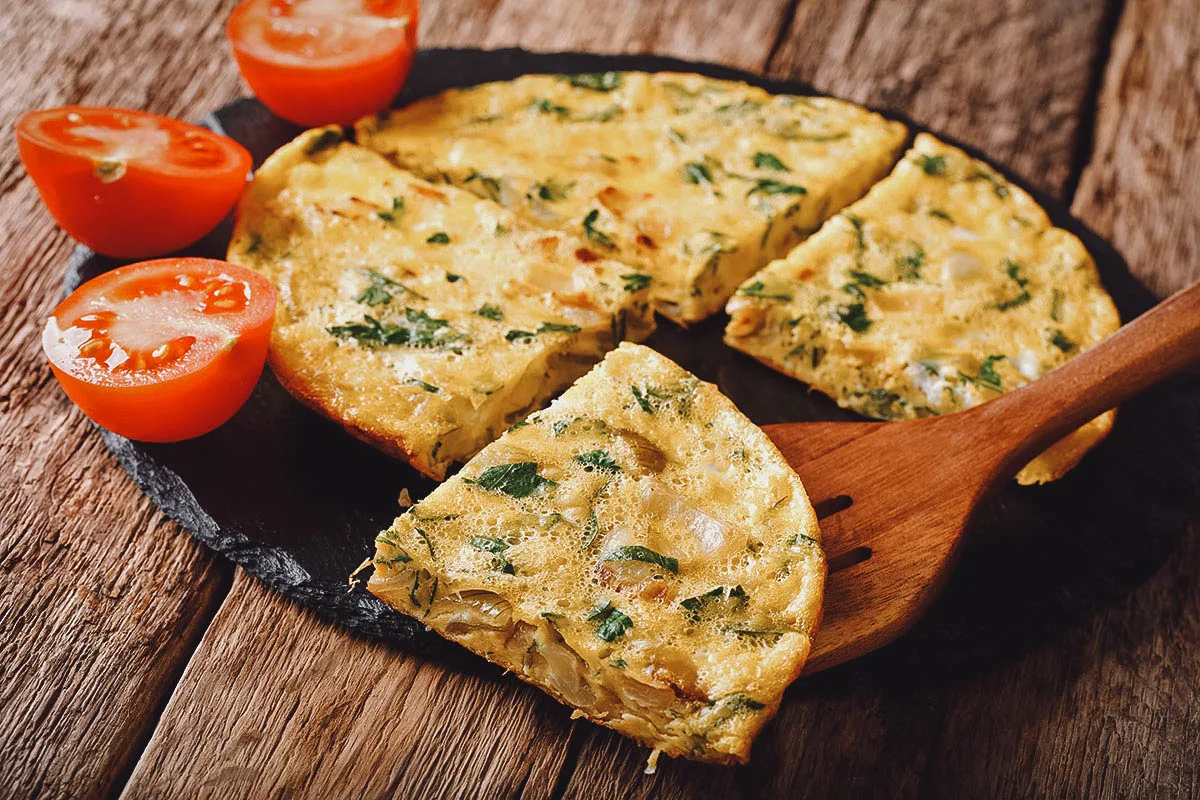
Photo by lenyvavsha
9. Falafel
No Egyptian food guide can be complete without falafel (or ta’ameya). Like koshari and ful medames, it’s one of the most well-known traditional Egyptian dishes.
A popular street food in Cairo and the rest of Egypt, felafel refers to deep-fried balls or discs made from ground fava beans, herbs, and spices. It’s widely consumed throughout the Levant but it’s believed to have its roots in Egypt where it’s considered a national dish.
Falafel is believed to have been invented by Coptic Christians in Egypt who used it as a replacement for meat during Lent. During Ramadan, it’s sometimes eaten as part of the meal (iftar) that breaks the daily fast after sunset. Commonly eaten for breakfast, it’s such a popular Egyptian food that you can order a McFalafel for breakfast at any McDonald’s in Egypt.
What makes the Egyptian version of falafel different is that it’s made with dried and ground fava beans, unlike the rest of the Middle East where it’s made with chickpeas. Aside from being lighter and more moist, Egyptian falafel also has a greener interior because it’s made with more herbs. According to many fans of the dish, this Egyptian version of falafel is still the best in the world.
No matter how it’s made, Egyptian falafel can be eaten on its own or as part of larger mezze platters. My favorite way of enjoying falafel is to stuff it in pita like a sandwich with tomatoes, onions, lettuce, and tahini sauce. Some hot sauce is always great too.
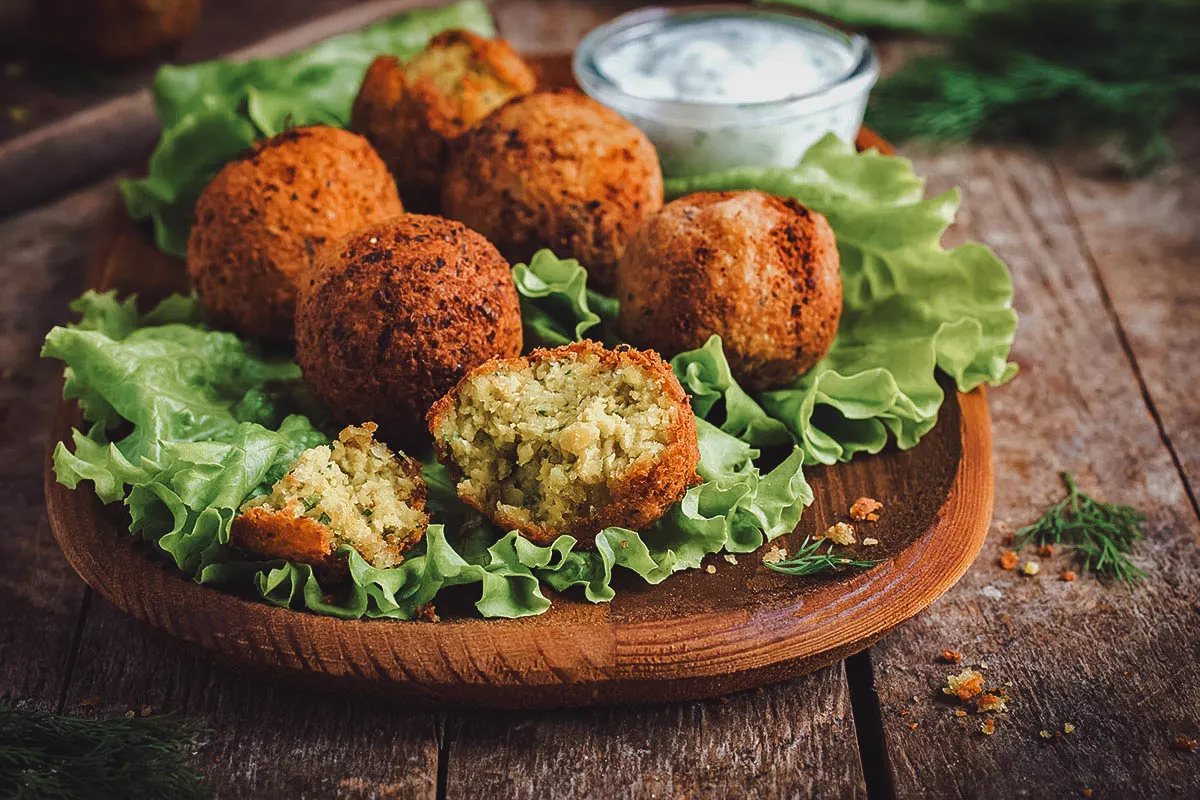
Photo by Anna_Shepulova
Thanks to delicious Egyptian dishes like ful medames and this falafel sandwich, Egypt has to be one of the easiest places in the world to be a vegetarian.
With two of Egypt’s national dishes being made with fava beans, it’s clear that this humble legume holds a special place in the hearts (and stomachs) of many Egyptians. According to food historian Ken Albala, eating fava beans is a “conscious act of nationalism” in Egypt. It’s an “expression of identity for modern Egyptians who choose to resist the onslaught of contemporary breakfast foods; it is a way to remember who they are.”
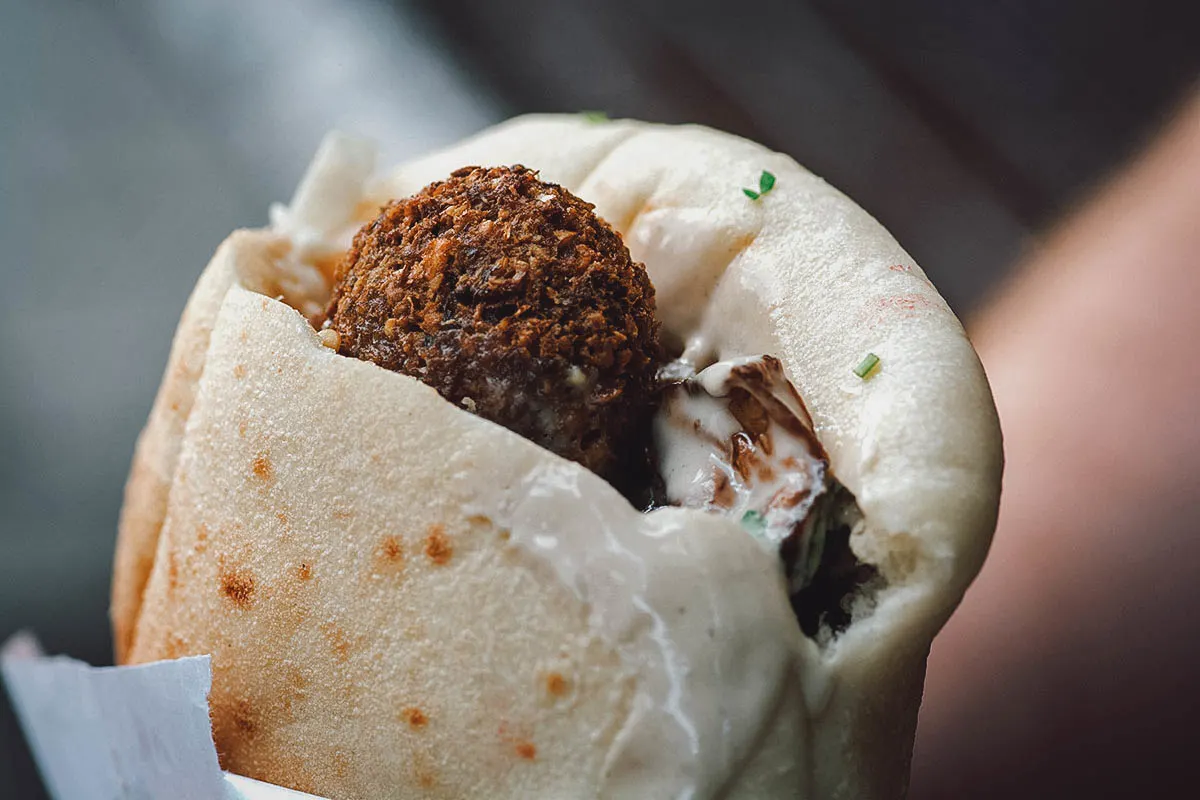
Photo by SingerGM
MEAT DISHES
10. Bamya
Bamya refers to a type of Egyptian stew made with okra and lamb simmered in a tomato sauce with onions, garlic, peppers, cilantro, and spices. It’s popular throughout the Mediterranean and the Levant where it exists in many variations. Bamya in Arabic means “okra”.
Bamya is a common dish in Egypt. It can be made with or without meat though many versions will contain some type of protein, usually lamb or beef. It’s often served with white rice or pita bread and a squeeze of lemon.
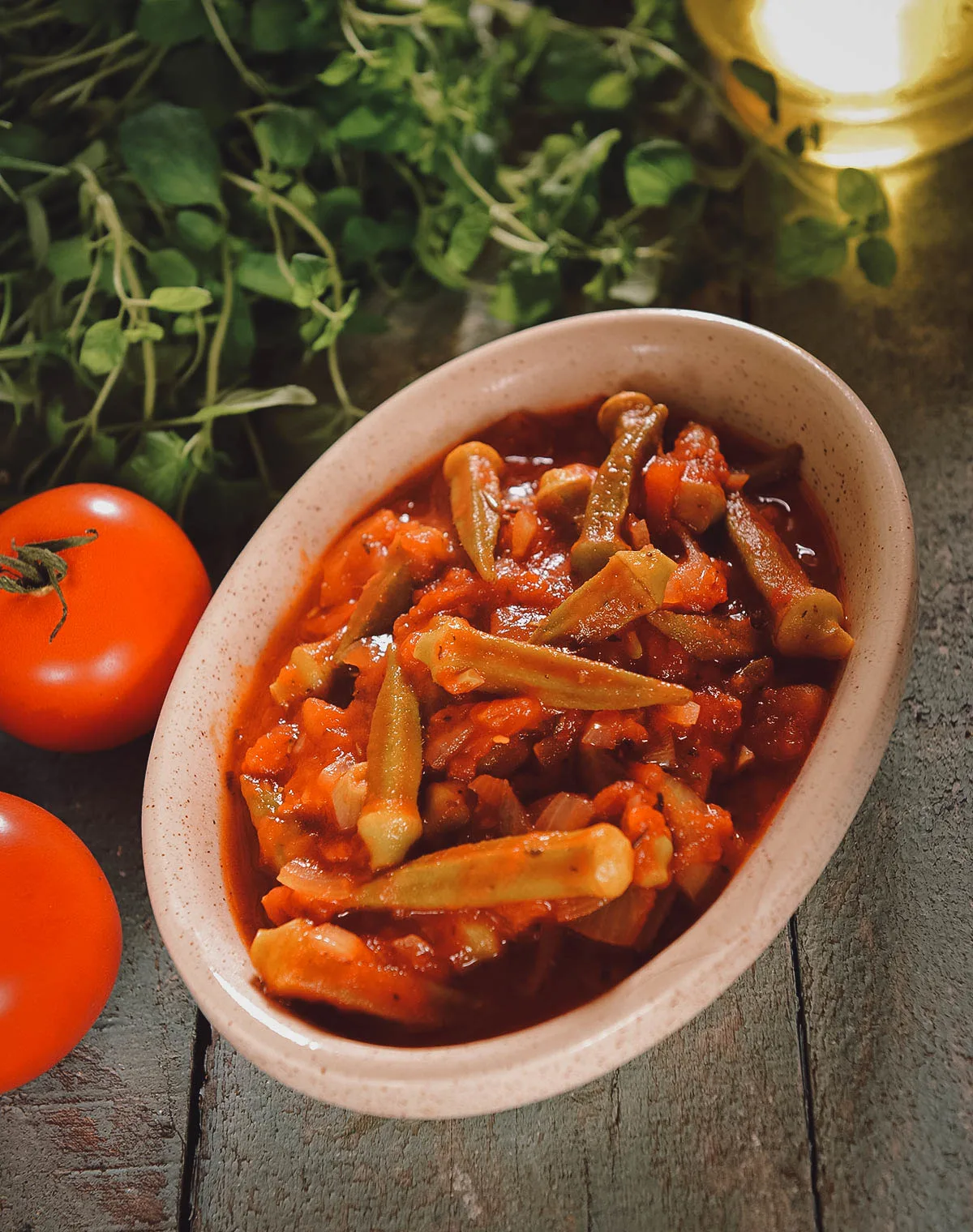
Photo by kwasny222
11. Kofta Kebab
Kofta (or kefta) refers to a family of meatball or meatloaf dishes popular throughout the Levant, North Africa, the Mediterranean, the Balkans, and the Indian subcontinent. In Egypt, they’re typically made with different types of seasoned ground meat but they can be made with other ingredients as well like fish and vegetables. Kofta can be formed into balls, patties, or cigars and cooked in any number of ways.
Kofta kebabs are skewered and grilled koftas. Recipes vary but they’re typically made with a mixture of ground beef and ground lamb with onions, garlic, and a host of herbs and spices like parsley, mint, sumac, nutmeg, cardamom, allspice, cumin, and paprika.
The meat mixture is molded over skewers and then grilled on each side for about four minutes. When ready, they can be eaten with white rice or pita bread and served with any choice of sides, salads, and dips.
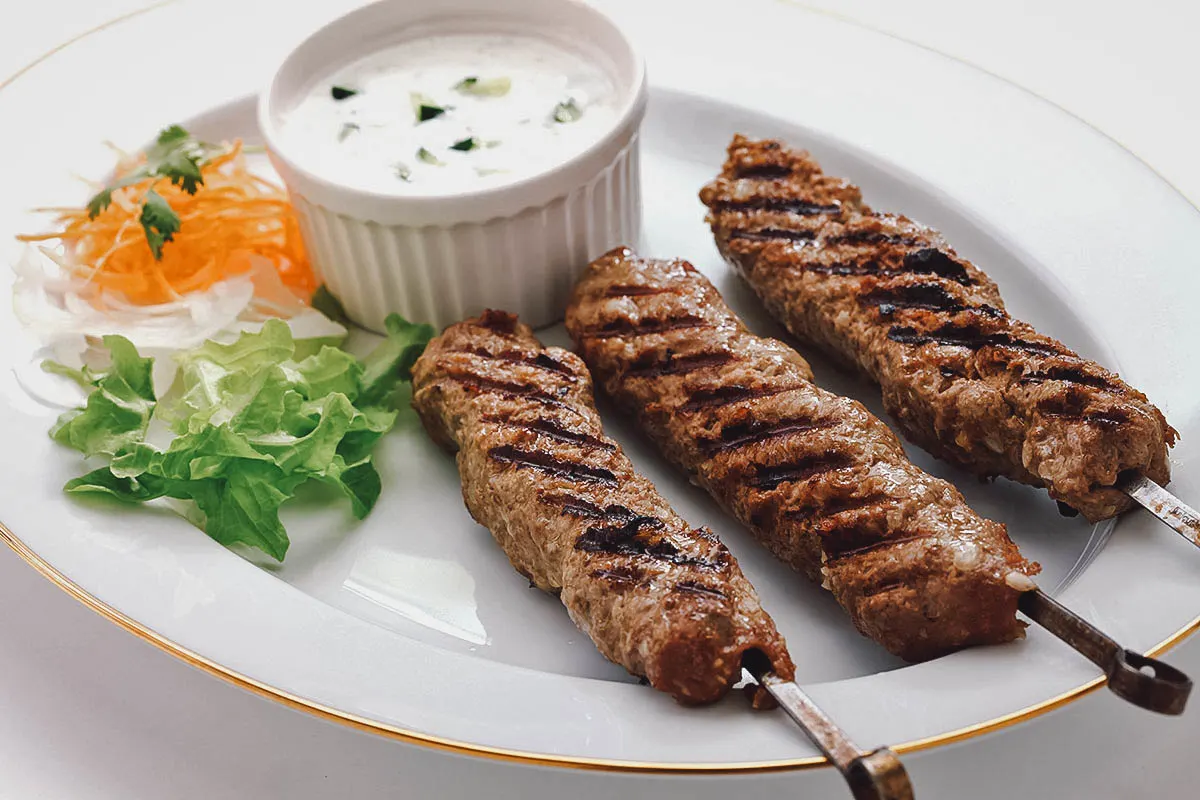
Photo by asimojet
12. Mombar
Mombar (or fawaregh) refers to a type of Egyptian sausage made from sheep intestines. It’s popular in the cuisines of Egypt and other countries in North Africa and the Middle East like Libya, Tunisia, Algeria, and Syria.
To prepare, sheep casings are stuffed with a mixture of ground beef, rice, garlic, onions, tomato paste, and seasonings. Recipes vary but commonly used herbs and spices include parsley, cilantro, cumin, coriander, and cinnamon. The sausages are first boiled in water before being fried to a nice golden brown color.
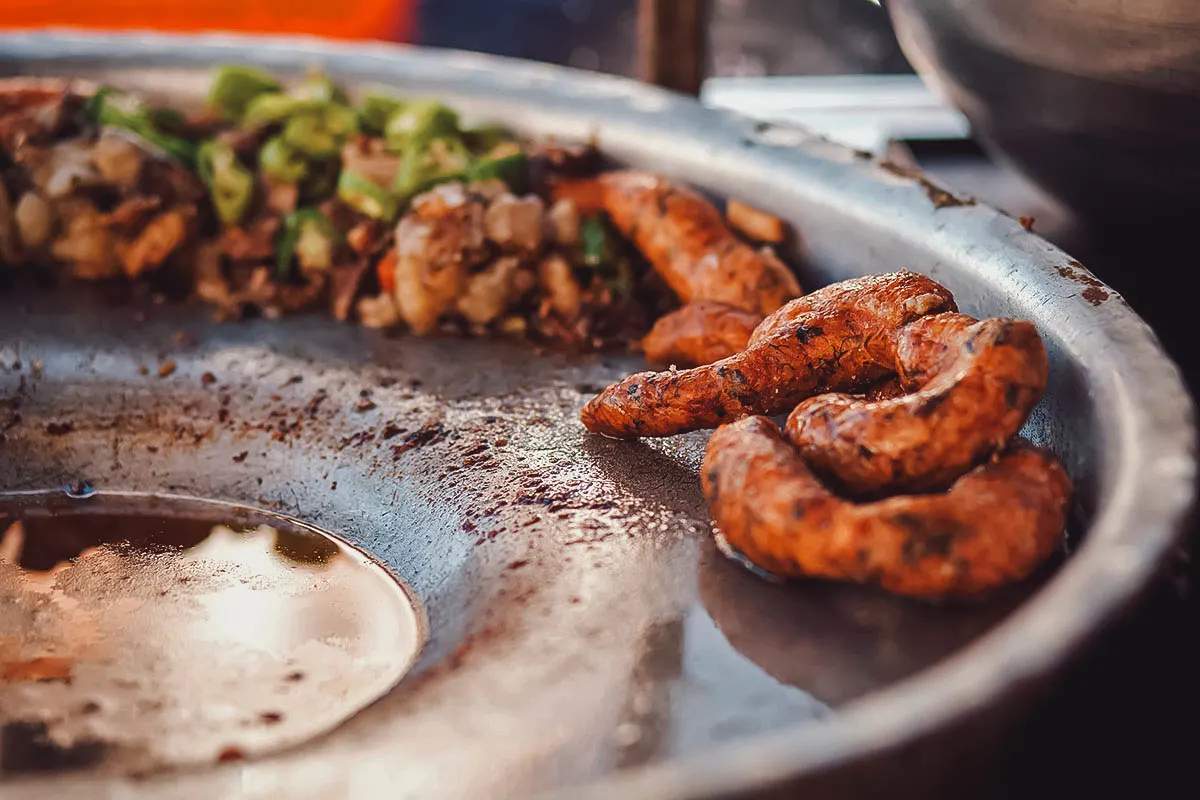
Photo by dexteris
13. Shawarma
Shawarma is one of my all-time favorite street foods. It’s a Levantine Arab dish that’s hugely popular as street food in Cairo and throughout Egypt. It’s widely consumed throughout the Middle East and beyond and was even famously referenced in an Avengers post-credit scene.
Shawarma consists of thinly shaved pieces of grilled meat sliced from a rotating vertical rotisserie. It’s typically served in pita bread as a pocket sandwich or wrap with onions, tomatoes, cucumbers, french fries, tahini sauce, and hot sauce.
To make shawarma, thin slices of heavily-spiced meat – usually beef, chicken, lamb, or mutton – are pierced and stacked onto a vertical skewer. Larger pieces are layered on top to create a cone-like stack measuring about 60 cm (20 in) high. A motorized spit then turns the stack against a vertical heating element to slowly roast the meat in its own juices and fat. It’s delicious and an absolute must-try in Egypt.
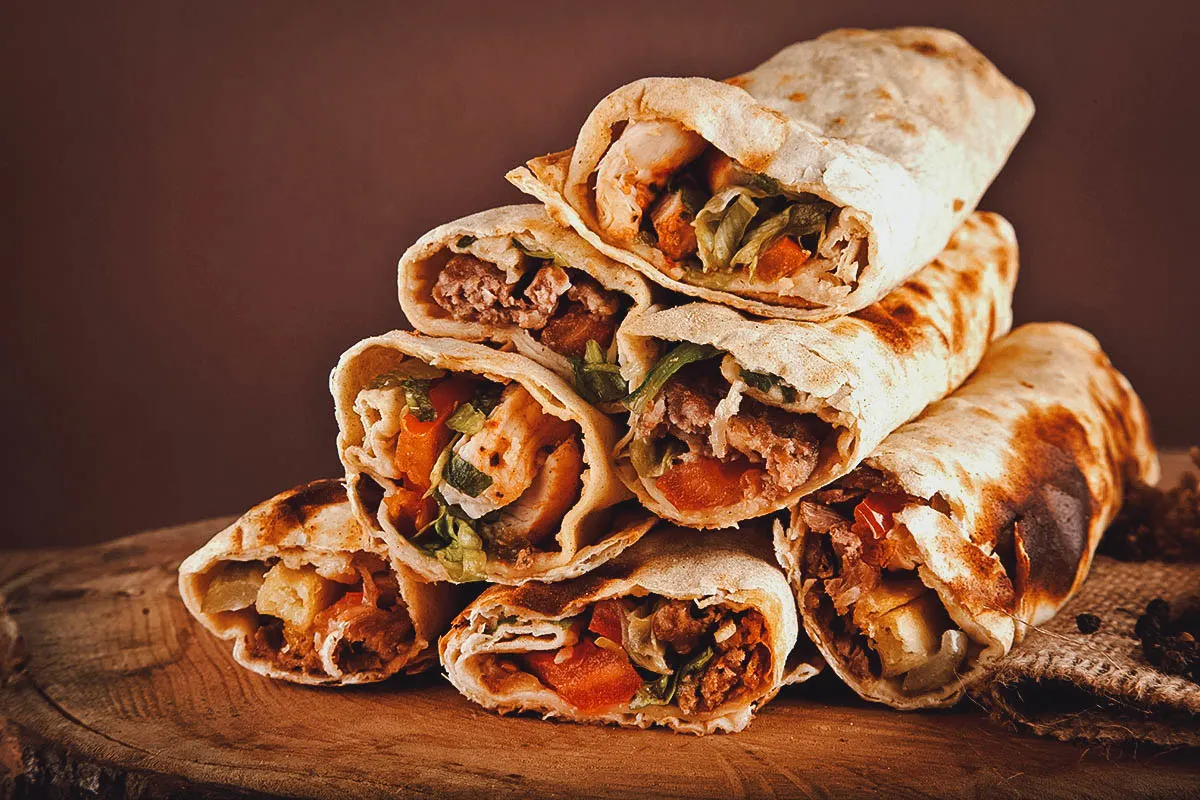
Photo by gorkemdemir
It’s interesting to learn that the shawarma is a descendant of Turkish doner kebabs, much like Greek gyros and Mexican tacos al pastor.
Gyros and shawarma are derived from the doner kebab which first appeared in the kitchens of the Ottoman Empire in the 19th century. Lebanese immigrants would then take the shawarma to Mexico in the early 20th century where it would further evolve into tacos al pastor.
Like the various iterations of pizza, it’s always interesting to trace the origins of a dish and see how it evolved to suit the local palate. Which of these vertical kebab dishes have you tried?
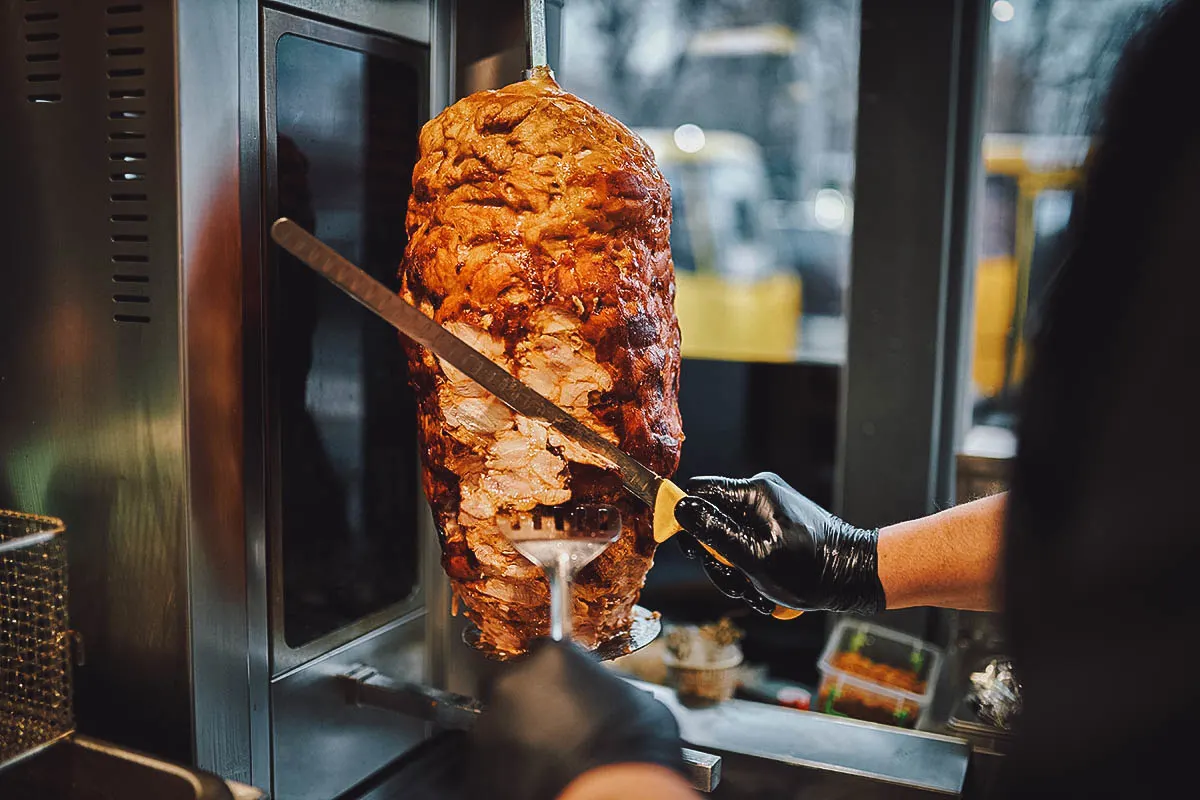
Photo by BLGKV
14. Kebda Eskandarani
Kebda eskandarani refers to a traditional Egyptian dish made with fried beef liver flavored with garlic, chili peppers, cumin, and cardamom. It’s a specialty of Alexandria where it’s commonly sold as street food.
Kebda Eskandarani is typically enjoyed as a sandwich but it can be eaten on its own as well with white rice, lime, and warm pita bread on the side.
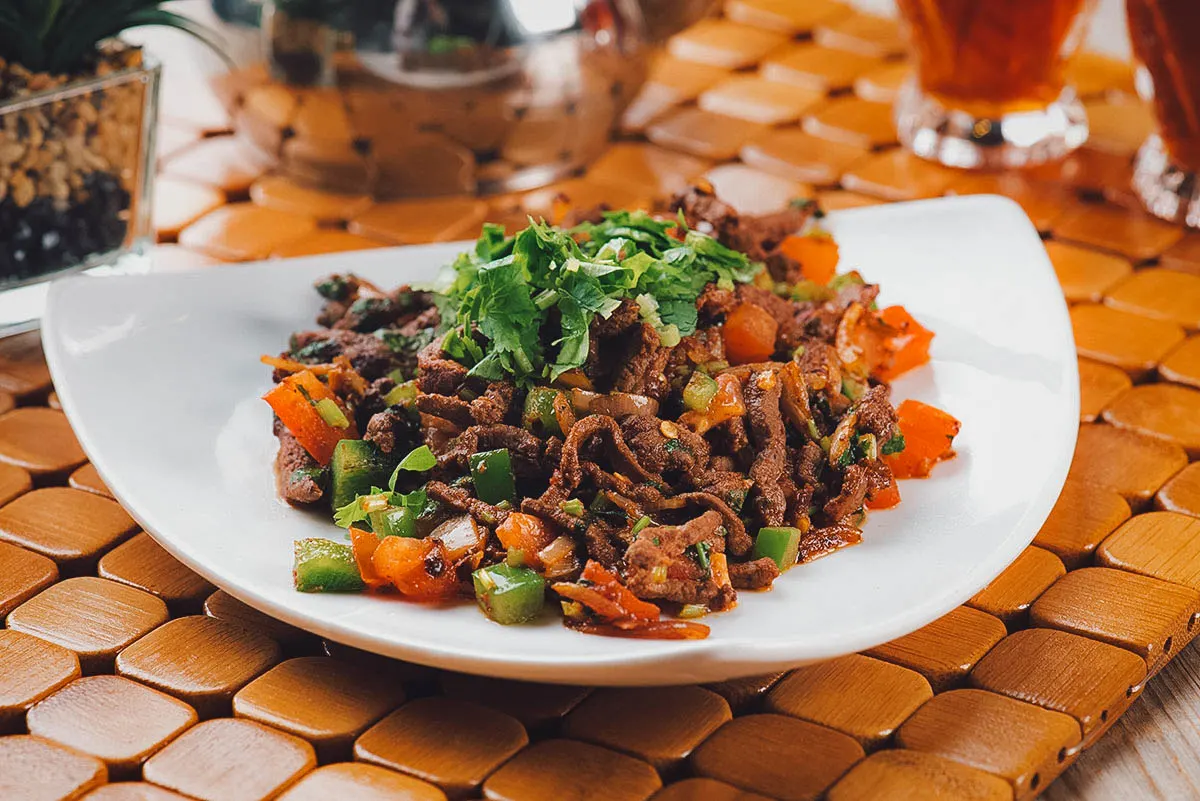
Photo by yuliang11
15. Hamam Mahshi
New Yorkers may find this next dish a little tough to stomach. Pigeons are viewed as pests in some cities but in Egypt, it’s considered a delicacy. Hamam mahshi refers to a traditional Egyptian dish made with stuffed squab or young domestic pigeon.
In Egypt, mother pigeons fatten up their young in dovecotes with a nutritious secretion called crop milk. To make hamam mahshi, Egyptian cooks select the fattest 6-week old squabs. Any older and the meat becomes too tough and muscular, similar to veal becoming beef.
To prepare, the squab is stuffed with a mixture of rice, freekeh (cracked wheat), onions, giblets, nuts, and spices. The bird is grilled or roasted on a spit before being served on a bed of cracked wheat. Hamam mahshi is traditionally a dish reserved for special occasions in Egypt, but these days, it shouldn’t be too hard to find on Egyptian restaurant menus.
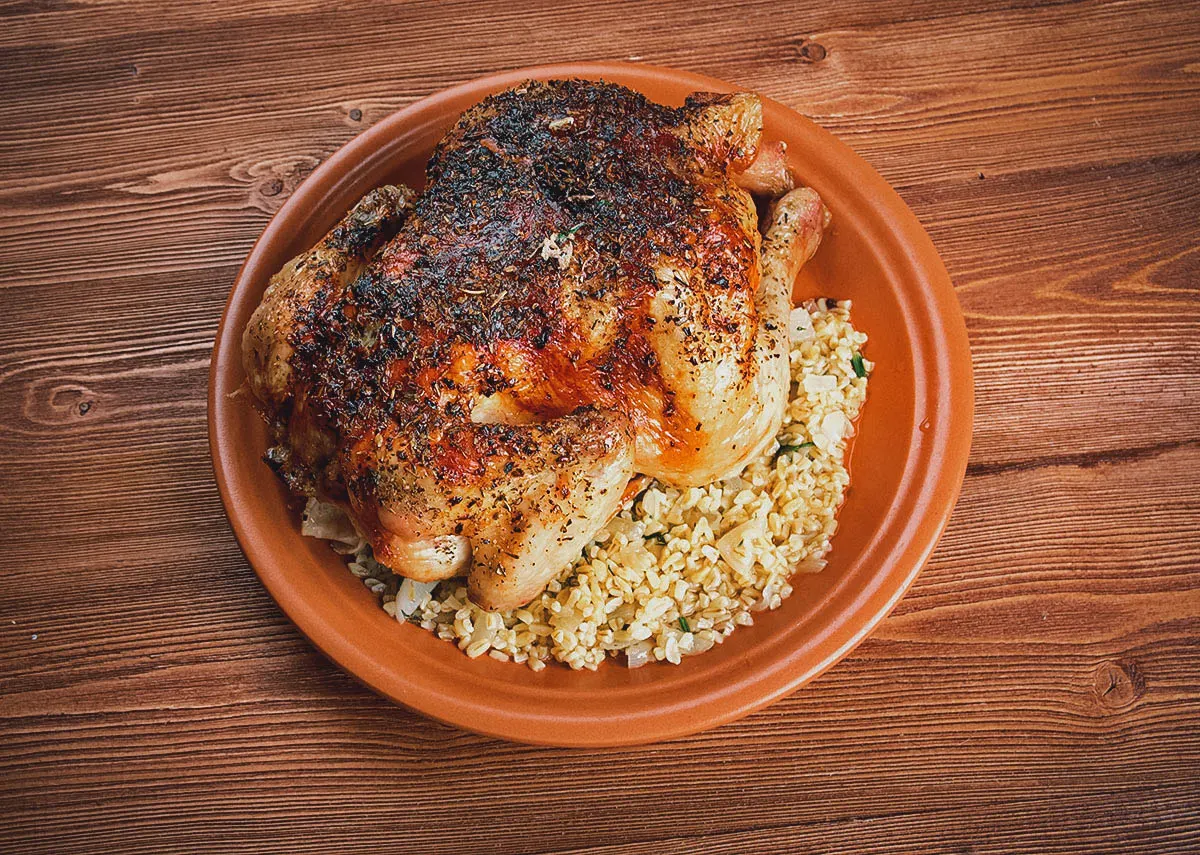
Photo by fanfon
16. Makarōna Beshamel
This next dish may not look like it belongs on an Egyptian food guide, but makarōna beshamel is an extremely popular dish in Egyptian cuisine. It’s essentially the Egyptian version of pastitsio, a Greek baked pasta dish made with ground meat and béchamel sauce. Makarōna beshamel, in Egyptian Arabic, means “macaroni with béchamel”.
Recipes vary but makarōna beshamel is typically made with penne or macaroni baked with bechamel and a minced meat sauce made from ground beef, onions, tomato sauce, and seasonings. It’s a common sight at Egyptian banquets and gatherings, especially over the holidays.
Makarōna beshamel was introduced to Egypt in the 19th century by Greek and Italian immigrants. Today, it’s one of the most beloved comfort foods in Egyptian cuisine.
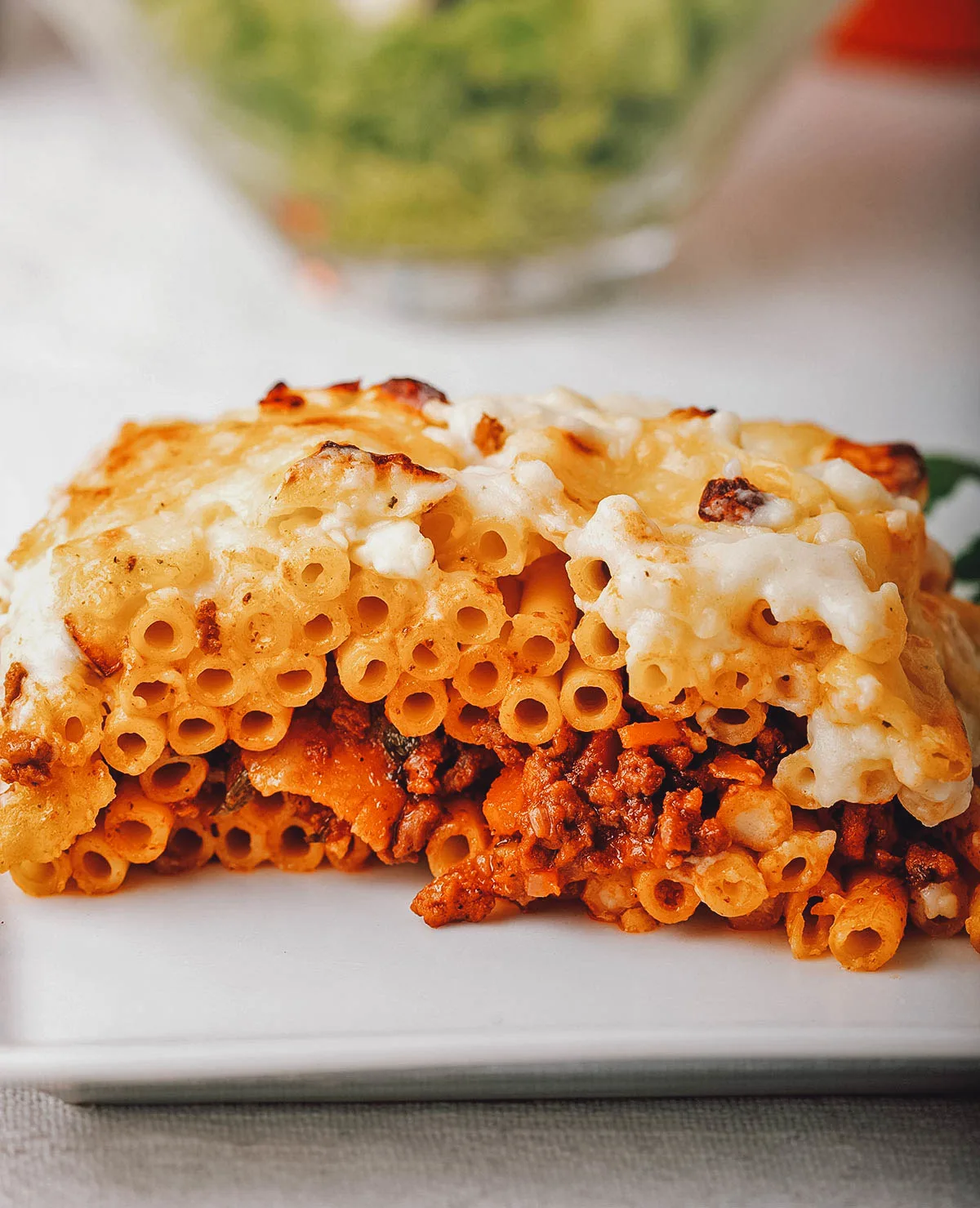
Photo by PantherMediaSeller
DESSERT
17. Kunafa
Kunafa (or knafeh, kunefe, konafa) is one of my all-time favorite desserts, not just in Egyptian cuisine but anywhere. It refers to a luscious Middle Eastern dessert made with layers of shredded phyllo pastry and milky sweet cheese. The dessert is soaked in simple syrup infused with rose water (or orange blossom water) and often topped with crushed pistachios and clotted cream.
Kunafa is popular in Egypt and the Levant and can also be found in many countries throughout the Balkans and the South Caucasus. It’s exact origins are unknown but one thing is clear – it’s one of the most beloved Middle Eastern pastries and considered by many to be the most iconic and representative dessert in Palestinian cuisine.
In Egypt, kunafa can be made in individual portions or in larger batches cut into smaller servings. It’s served bubbling hot so be sure to eat it right away. You’ll be rewarded with a deliciously gooey interior that comes away in strings with every forkful. It’s so good, especially when paired with a hot cup of mint tea.
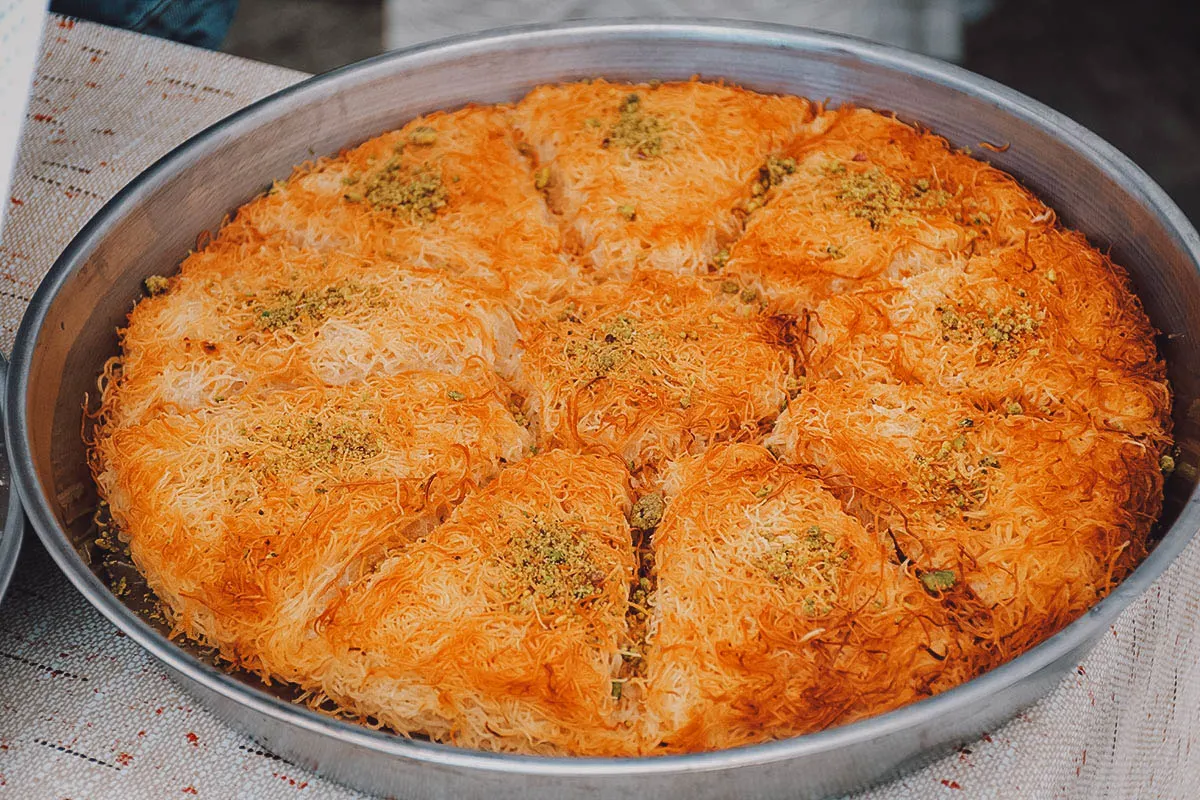
Photo by [email protected]
18. Baklava
Like kunafa, baklava is made with layers of phyllo pastry and is one of the most well-known desserts in Mediterranean cuisine. It’s popular in Egypt, Turkey, Greece, Iran, and in many other countries throughout North Africa, the Middle East, the Balkans, the South Caucasus, and Central Asia.
Baklava comes in many regional forms but at its core, it’s a crisp and flaky dessert made with multiple sheets of phyllo pastry layered in a pan with chopped nuts (typically pistachios, walnuts, and hazelnuts), butter, and spices. The dessert is cut into rectangles or diamonds before being baked and drizzled with a simple syrup infused with honey, rose water, or orange blossom water.
Like kunafa, the origins of baklava are unclear but the present version of the dessert is believed to have originated from the kitchens of the Ottoman Empire.
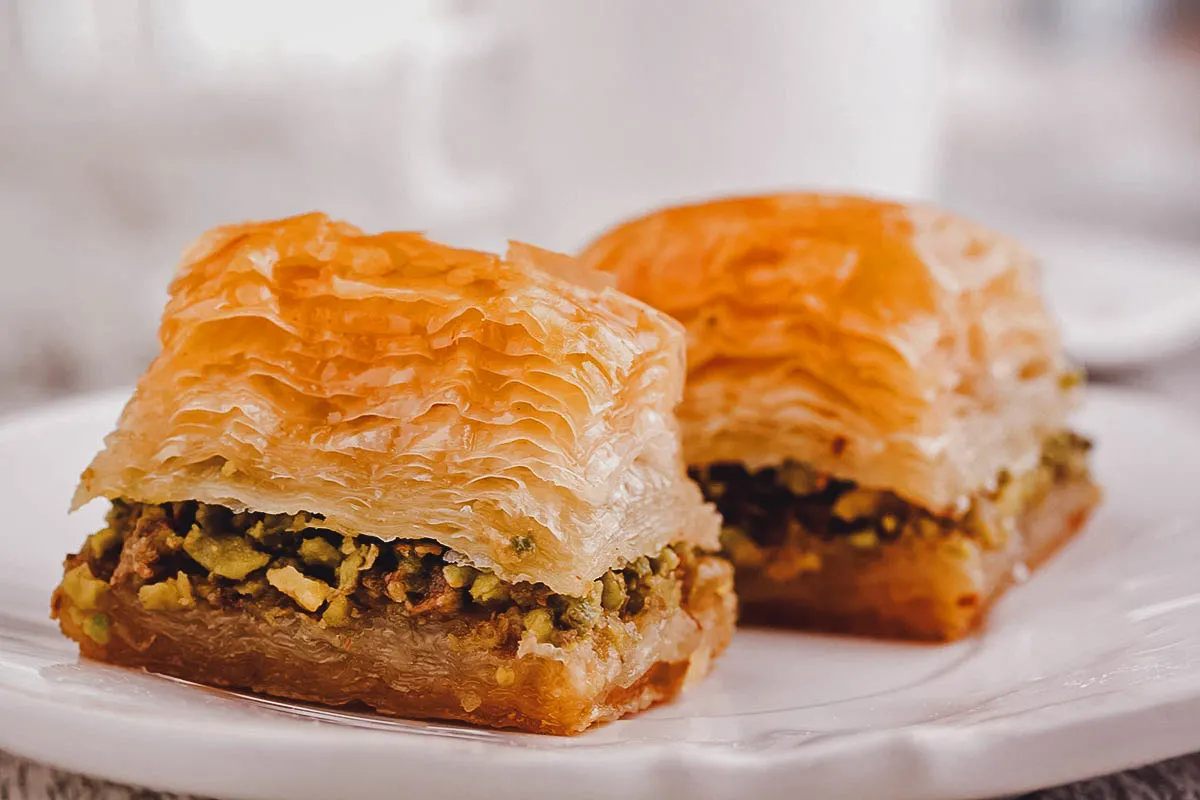
Photo by Bernashafo
19. Qatayef
Qatayef (or katayef) refers to a popular Arabic dessert commonly served during Ramadan. They’re essentially small Arabic pancakes that have been folded over and filled with sweet cheese and a variety of nuts.
To prepare, qatayef batter is poured onto a skillet to cook. Unlike western pancakes, only one side of the qatayef is cooked. It’s then filled with unsalted sweet cheese and a variety of nuts like pistachios, walnuts, almonds, and hazelnuts.
Qatayef is commonly made at home or sold as street food in Egypt. It’s available everywhere during Ramadan and can be eaten plain or drizzled with simple syrup or honey.
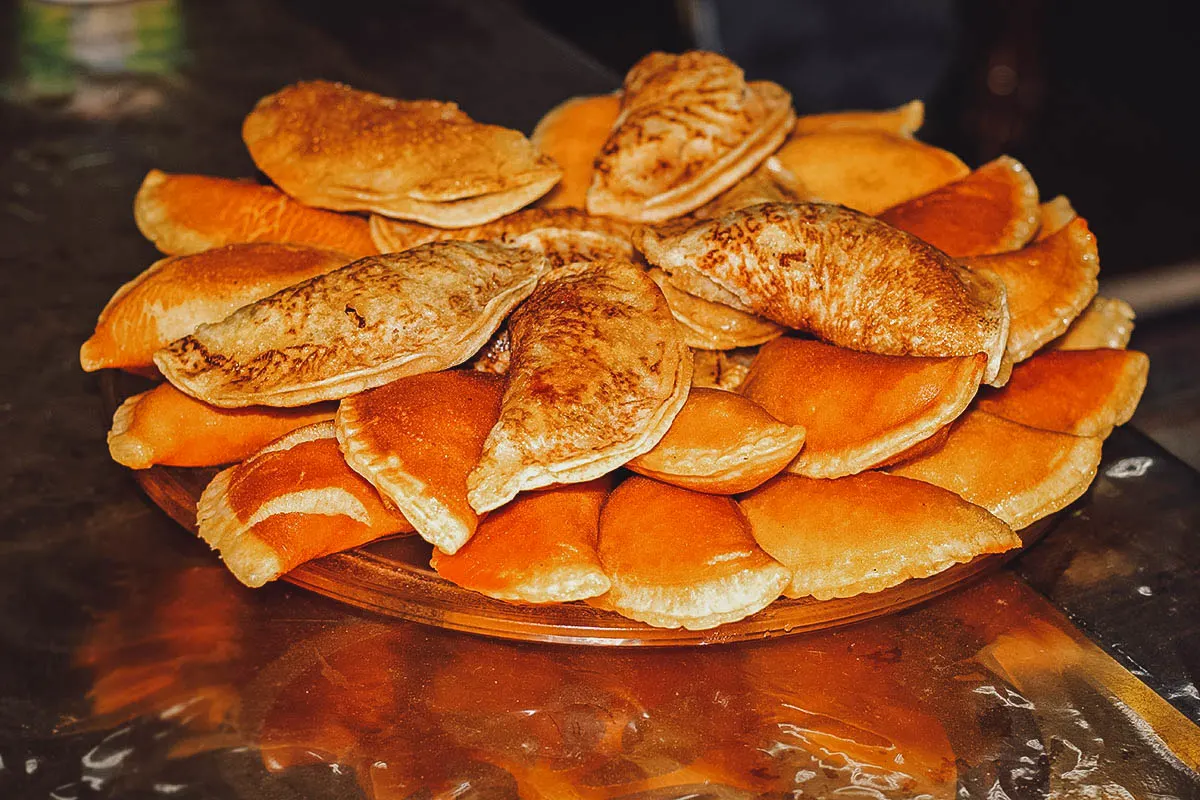
Photo by [email protected]
20. Basbousa
Basbousa is a type of Egyptian cake made with semolina, coconut, and yogurt. Popular throughout the Middle East, North Africa, and the Balkans, it’s sweetened with simple syrup infused with rose or orange blossom water and decorated with nuts like almonds or pistachios.
Basbousa is sold everywhere in Egypt. Every Egyptian bakery has its own secret recipe along with the dozens of versions made at home. When doing research for this article, I came across multiple Egyptian food blogs that claim to have made this dessert hundreds of times in an attempt to perfect its recipe. Apparently, it’s not that easy.
So important is this dessert to Egyptian culture that the word basbousa is often used as a term of endearment to refer to loved ones. Egyptian mothers would sometimes call their children basbousty, which is like saying “my basbousa” or “my sweet”.
Though they look alike, it’s important not to confuse basbousa with revani (or ravani), a similar type of semolina cake made with eggs and flour.
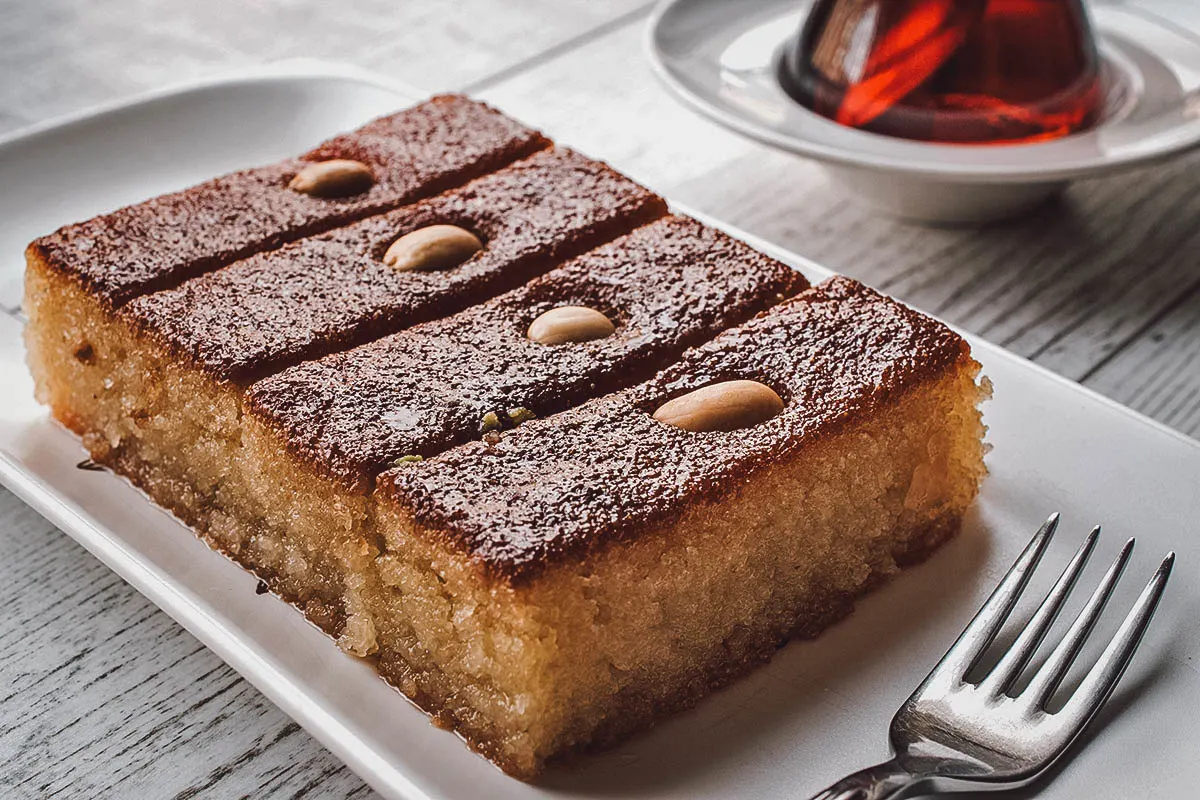
Photo by Alp_Aksoy
21. Ka’ak al-Eid
Ka’ak al-Eid, or simply “kahk”, are small circular Egyptian biscuits dusted with powdered sugar and filled with various ingredients like agameya (mixture of honey, nuts, and ghee), pistachios, or dates. They date back to ancient Egypt but are eaten throughout the Middle East to celebrate Eid al-Fitr at the end of Ramadan.
Cookies are a vital component of the Eid celebration with kahk being the most important of them all. They’re important to both Egyptian Muslims and Christians alike, and feature prominently in other celebrations like Easter, Christmas, and weddings.
Kahk can be made plain or stamped with an ornamental design or pattern, a practice that dates back to ancient Egypt. Cookies were made in a variety of geometric shapes and imprinted with designs that carried certain meanings and stories.
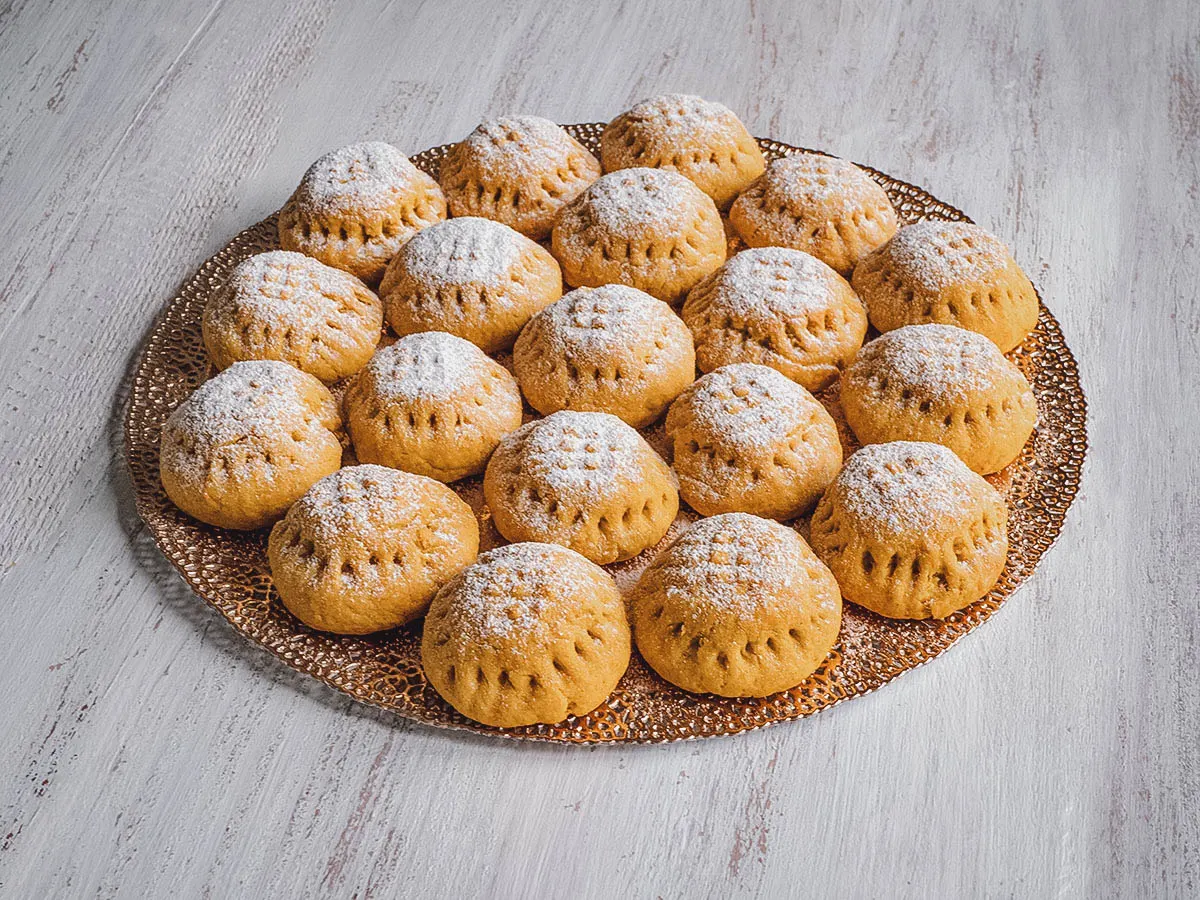
Photo by sablinstanislav
22. Ghorayeba
Ghorayeba (or ghraybeh, ghoraybeh) is a type of Egyptian shortbread cookie made with just three ingredients – ghee, flour, and powdered sugar. In other parts of the Middle East like Syria and Lebanon, they’re often flavored with orange blossom or rose water but the Egyptian version is flavored with nothing but the ghee it’s made with.
Like kahk, ghorayeba is an Egyptian celebration cookie that’s baked especially for Eid and other celebrations like Easter and Christmas. When done right, it’s known for its distinctive fine crumb and smooth buttery lightness that practically disintegrates in your mouth.
Ghoryeba is made with just three essential ingredients but it’s often garnished with nuts like pistachios, almonds, or cashews.
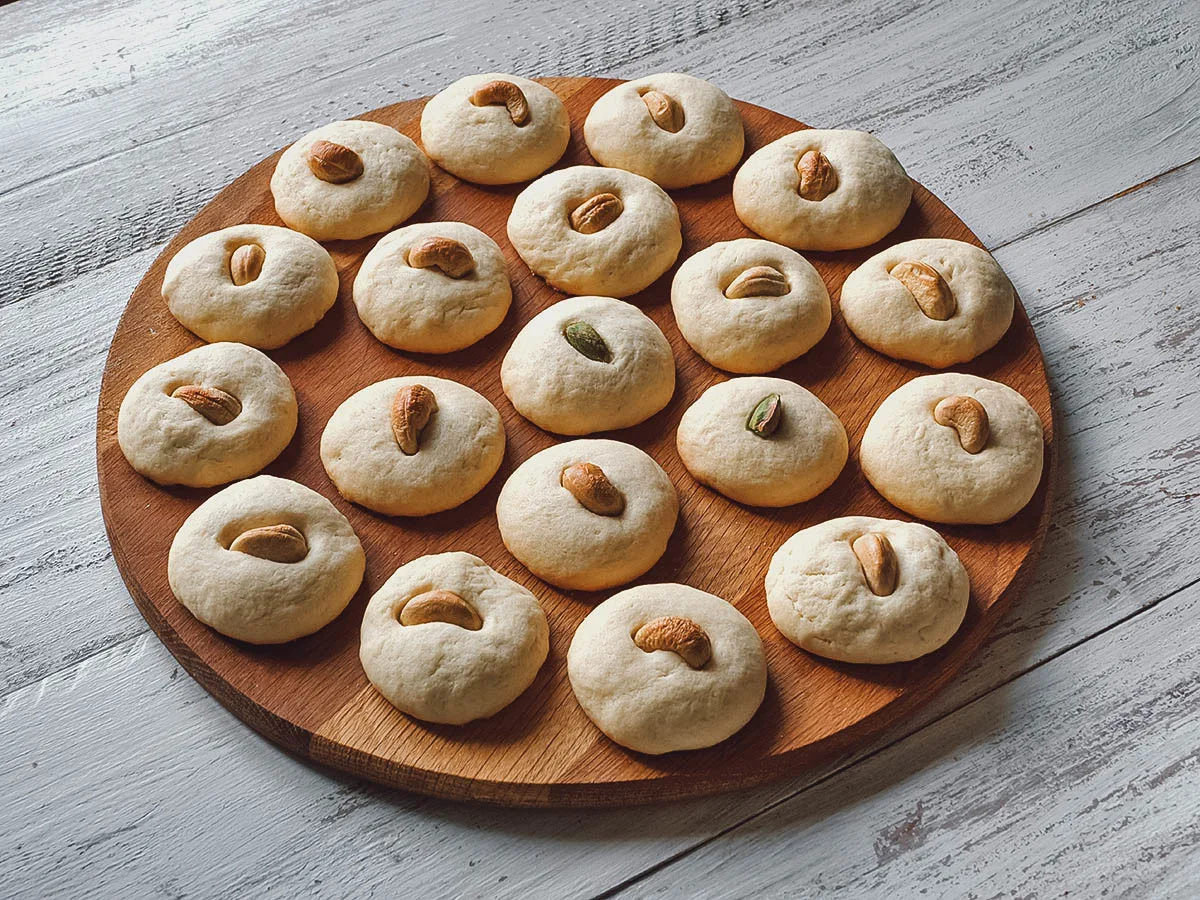
Photo by sablinstanislav
23. Roz Bel Laban
Roz bel laban (or ros bil laban) refers to an Egyptian rice pudding made from short grain rice, milk, butter, vanilla, sugar, cinnamon, and nutmeg. It can be infused with rose or orange blossom water and garnished with raisins and chopped nuts for color and texture.
In any culture, few dishes are more comforting than an old-fashioned bowl of rice pudding. Best enjoyed with a hot cup of mint tea, roz bel laban can be served warm or chilled and is typically eaten for breakfast or as a snack in Egypt.
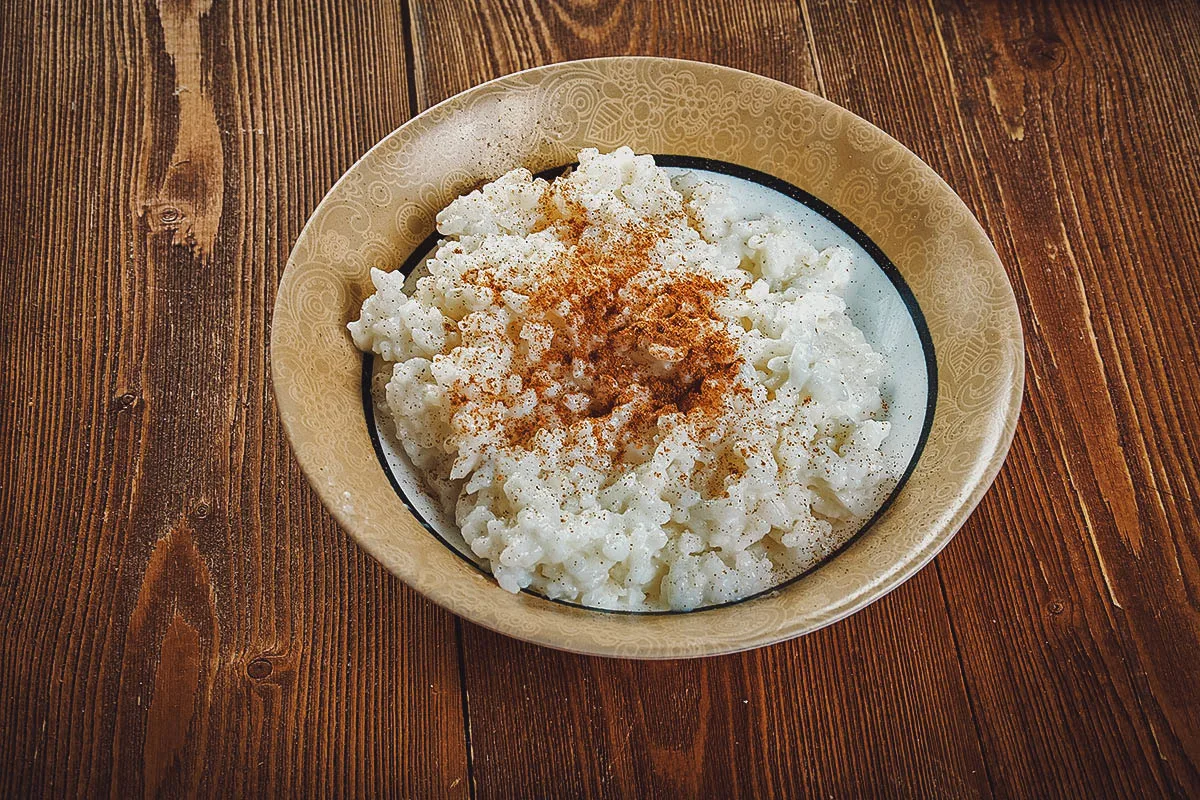
Photo by fanfon
24. Om Ali
Do you like bread pudding? If you do, then you’re probably going to enjoy om ali, Egypt’s answer to this carb-y dessert made with stale bread and milk. It’s so popular that it’s considered by many to be a national dessert of Egypt.
Om ali (or umm ali, oumm ali) is an Egyptian bread pudding made with milk, sugar, and some type of pastry like phyllo or baked puff pastry. Unlike many types of bread pudding, it isn’t made with any eggs, making it lighter and milkier and less custardy in texture. The pastry is soaked in milk and sugar and then baked in an oven before being garnished with chopped nuts, shredded coconut, raisins, and cinnamon.
There’s an interesting story as to how this popular Egyptian dessert got its name. Om ali literally means “mother of Ali”. It’s named after the first wife of Izz al-Dib Aybak, a Mamluk sultan from 13th century Egypt.
Legend has it that Shajar al-Durr, the latest wife of Sultan Aybak, plotted to have him killed so she could become the ruler of Egypt. She succeeded, but was ultimately murdered herself in retribution. After her death, Om Ali had a special dessert made in celebration. The dish became popular throughout Egypt and was named after her.
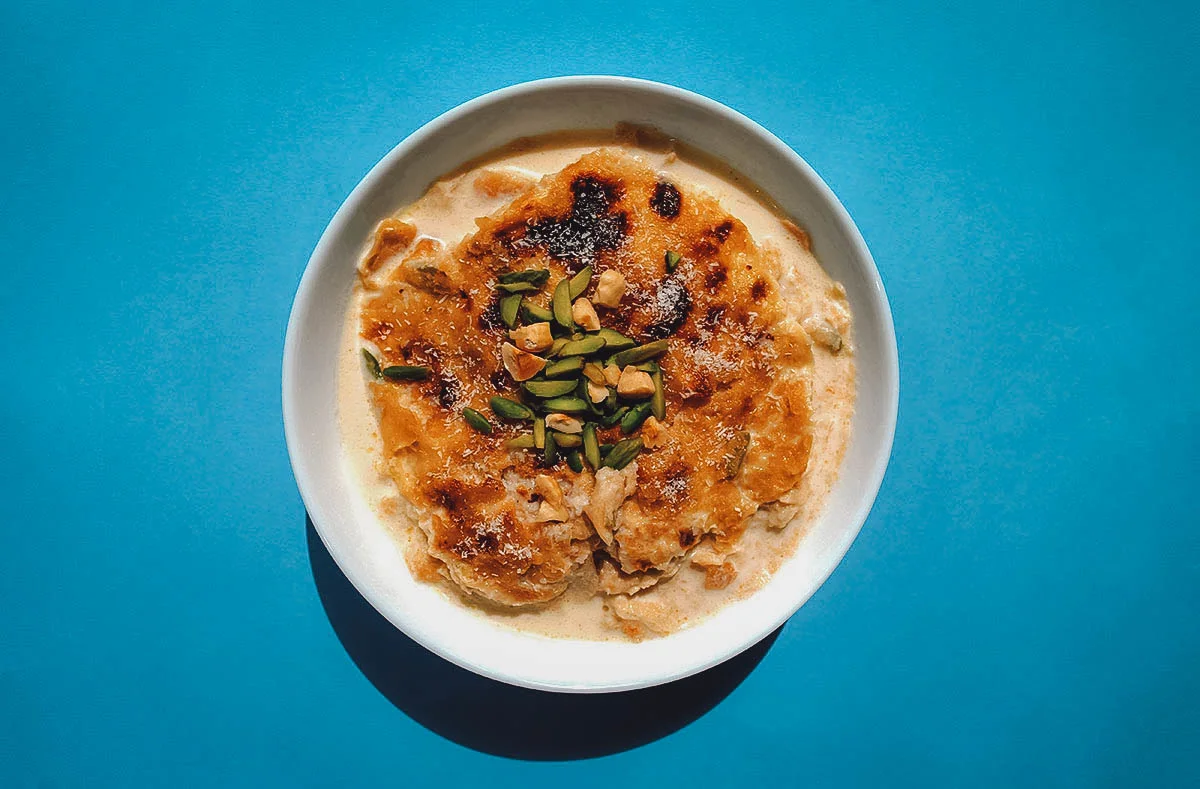
Photo by ViktoriyaF
25. Sahlab
We first got a taste of this intriguing drink in Turkey and have never forgotten it. Sahlab (or salep) refers to both the drink and the flour used to make it. This thick, creamy, and fragrant drink is made with flour derived from the dried tubers of Orchis mascula, a genus of wild orchids.
Sahlab is traditionally made with orchid flour but these days, these flowers are becoming more rare and expensive so the drink is often made with sorghum flour or cornstarch instead. A mixture containing rice flour, cornstarch, shredded coconut, powdered milk, sugar, and vanilla is dissolved in milk and brought to a boil until it thickens. It’s then served hot or warm in cups garnished with cinnamon, raisins, and nuts.
Sahlab is a warming Egyptian drink typically consumed in winter, either in the morning for breakfast or later in the afternoon. It has a thick consistency, similar to a thin pudding or a milkshake.
Interestingly, sahlab was once viewed as a powerful aphrodisiac by ancient Romans and used as a fattener for young women in the Ottoman Empire, to make them more plump before marriage.
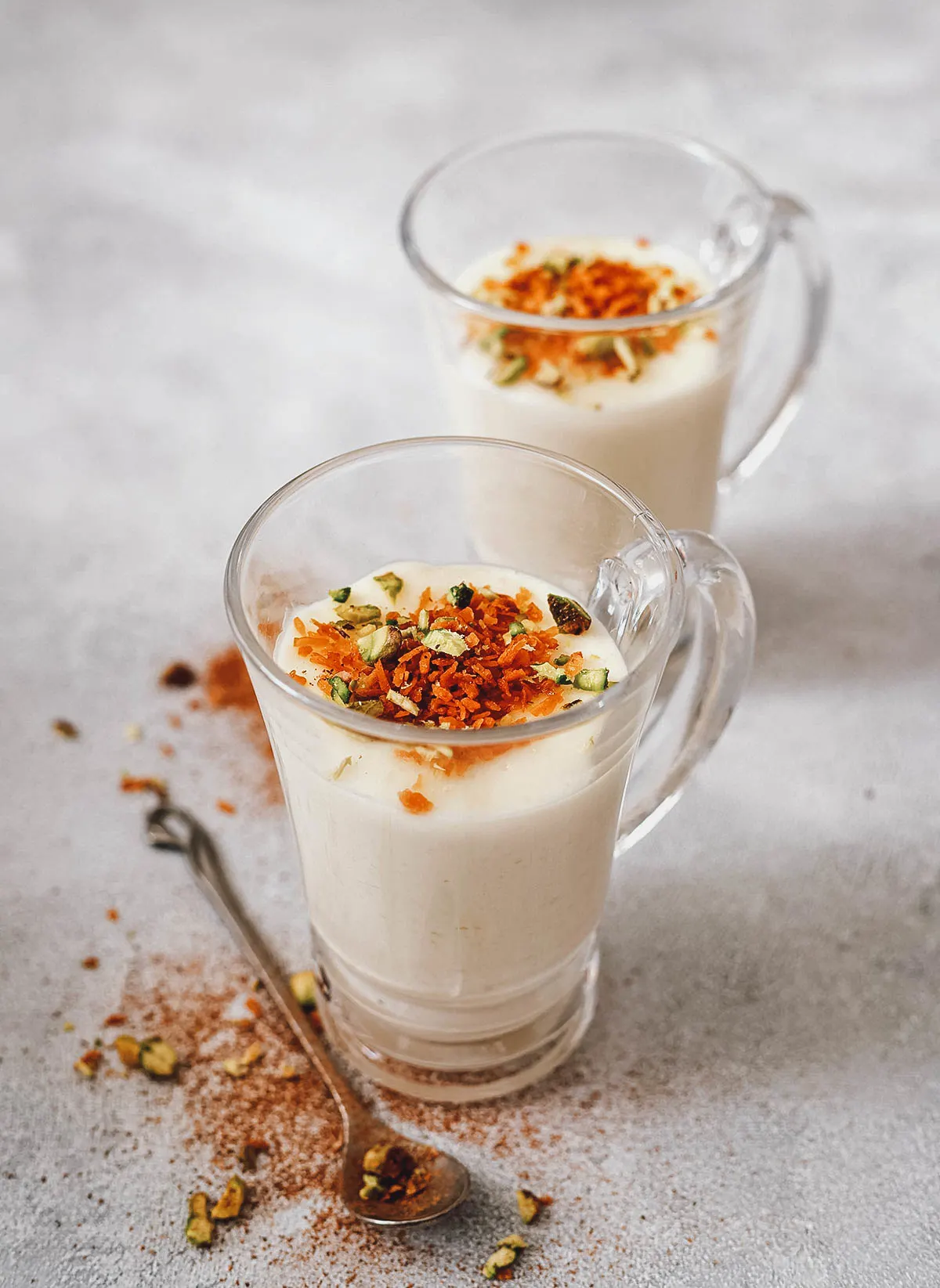
Photo by Vitoria71
FINAL THOUGHTS ON TRADITIONAL EGYPTIAN FOOD
Attractions like the Pyramids of Giza and the Nile River make Egypt one of the most visited countries in Africa. It’s a dream destination for many people, one that rarely disappoints.
The pyramids will always be its top draw but Traveleaters who put as much stock in the local food as they do in these iconic attractions will find much to be excited about when it comes to traditional Egyptian food.
If you have a taste for vegetarian dishes and Middle Eastern cuisine, then you’re going to love Egyptian food.
Disclosure
Some of the links in this Egyptian food guide are affiliate links. If you make a booking, then we’ll earn a small commission at no additional cost to you. As always, we only recommend products and services that we use ourselves and firmly believe in. We really appreciate your support as it helps us make more of these free travel and food guides. Thank you!
Cover photo by fanfon. Stock images via Depositphotos.


Chef Given
Monday 22nd of January 2024
I'm a chef in an Egyptian hospital in zambia,very happy to through this list it will so helpful.
Nisar
Thursday 2nd of June 2022
Do try Grand Arabesk in Dubai. I bet, you will love it. It is the most authentic Egyptian Food Restaurant in Dubai.
JB & Renée
Monday 6th of June 2022
Thanks so much for the tip Nisar!
Jojo
Thursday 26th of August 2021
Really enjoyed this list! It was nice seeing dishes I’ve never heard of and learning a bit about the ones I have. Looking forward to trying all these some day!
JB & Renée
Friday 27th of August 2021
Happy to hear you enjoyed it Jojo! Thanks for reading. :)